
Home » News » Essay: The Healing Power of Nature

Essay: The Healing Power of Nature
October 15, 2019 October 30, 2019
While waiting for a hike to begin during Earth Week last spring at Kehl Lake, I felt my phone buzzing in my pocket. Glancing at the screen, I saw it was a close friend of mine, a college roommate, who dislikes talking on the phone, and almost never calls. I picked up.
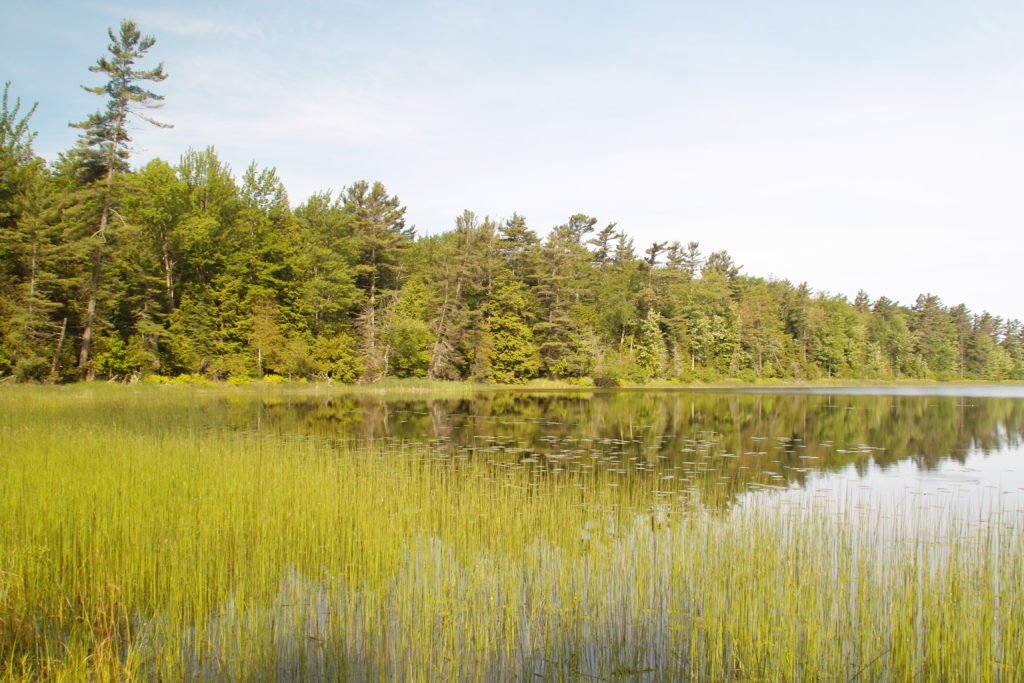
My friend could hardly speak but managed to get the words out that her daughter, 28, had died that morning of a drug overdose. She had just heard the news. It was a call that I had somehow always expected I might get, and yet it nearly took me to my knees.
Her daughter had struggled with addiction mightily for 12 years. She was bright, beautiful, married and a mother to an adorable three-year-old. This was a girl who my own two sons thought of as a cousin. She loved Leelanau and came up every summer with her mom and younger brother, to stay with us for a week. I can still see her jumping off our raft, or surfing the waves at Van’s Beach, or toasting marshmallows by firelight, her long dark hair pulled back.

But tragically, as in so many cases across our nation, her drug addiction trumped everything. We went downstate to be with my friend and to attend the funeral. In the days that followed, I felt alternately numb and perpetually on the verge of tears, sad for my friend and incredulous at her unimaginable loss.
I came back to work later that week and our staff carpooled out to tour the new Cedar River Preserve addition. Our Board had just taken the leap of faith to buy this incredible 80 acres that could have easily become a ridgetop development, with its sweeping views of Lake Leelanau.
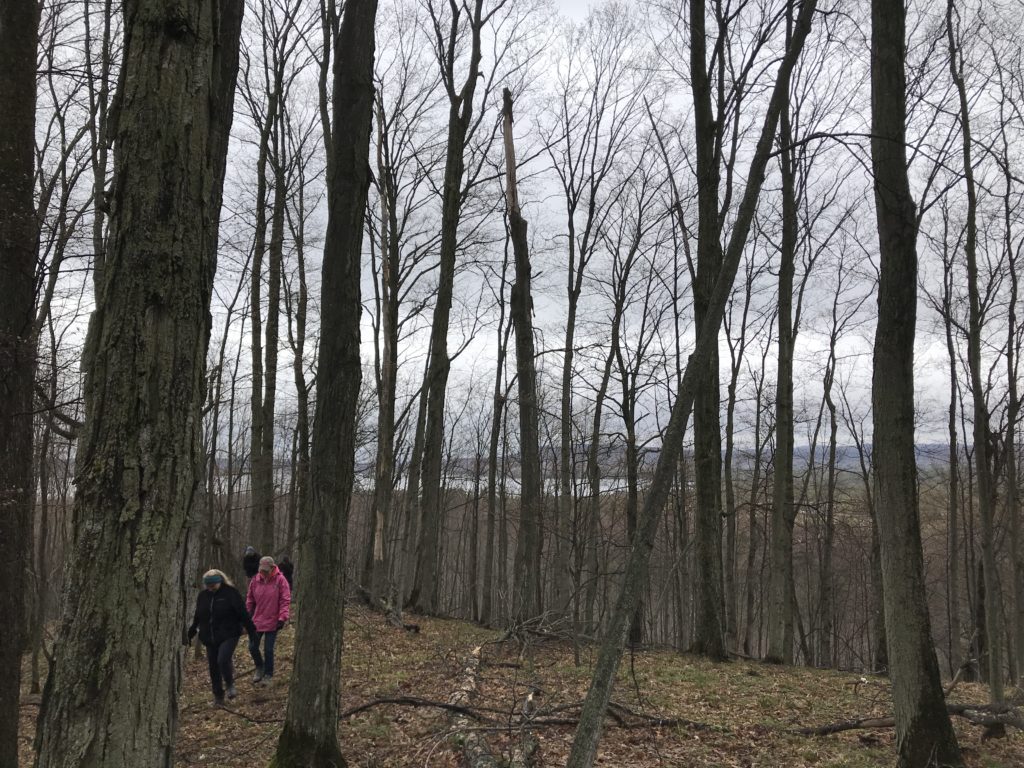
It was a cool and overcast May afternoon as we trekked up and along the ridgeline. The trees were still stark and bare. But the bright green of spring ephemerals on the hillside took my breath away, contrasting beautifully against the darkness of a forest floor rich with leaf litter. Iridescent moss and patterned lichen fanned out on decaying logs. We heard a cacophony of birdsong and looked down on a kettle hole lake, formed by the glaciers.
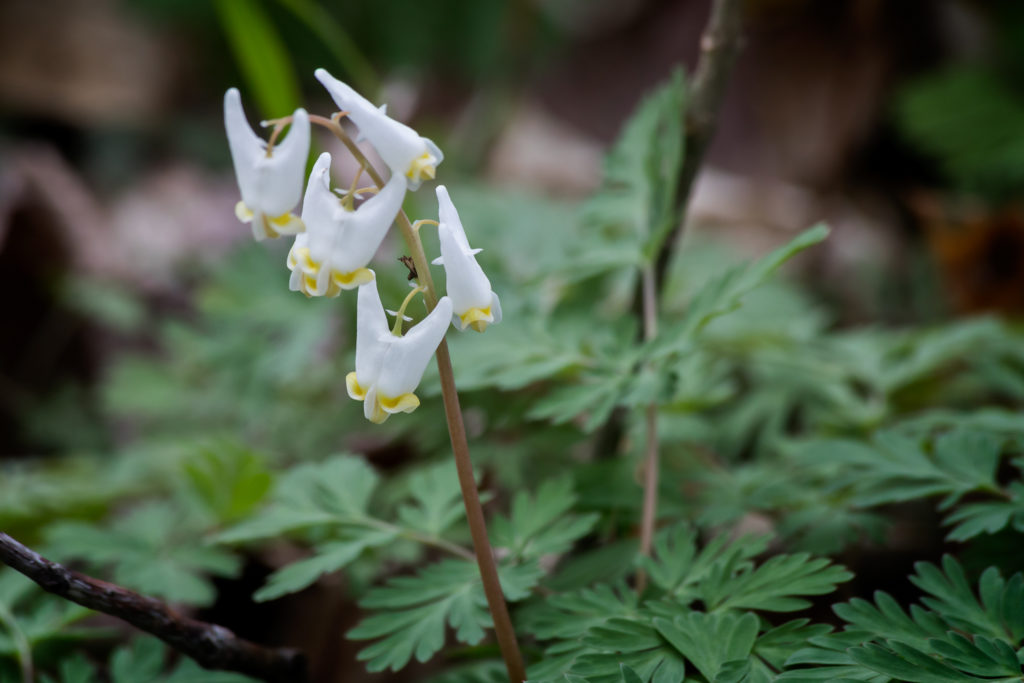
For the first time in weeks, I felt something ease in me. Seeing all of the new life after such a long, brutal winter felt hopeful. The ancientness of the kettle hole, the girth of old-growth trees, even the skeleton of what appeared to be a deer gave me a kind of peace and perspective that only nature can provide. Life and death are intertwined so beautifully and naturally in the out of doors. It gave me comfort to be reminded that each of us is just a small speck in time, whirling through a very big universe. Somehow, it felt easier to accept the death of my friend’s daughter.
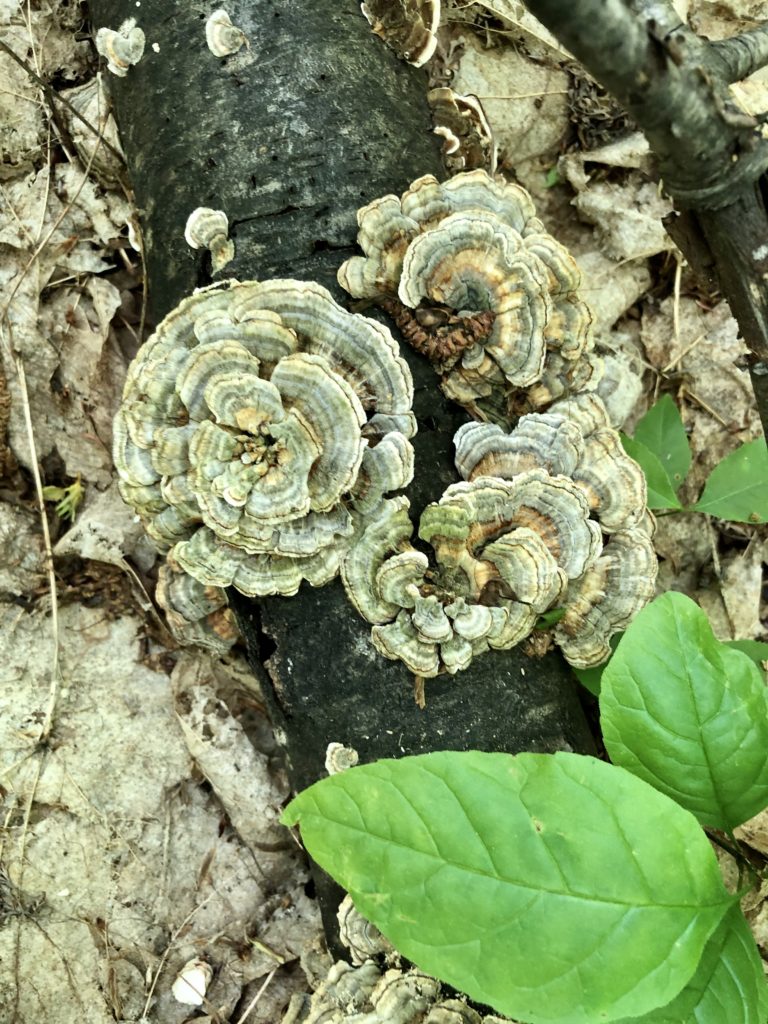
I couldn’t be more grateful that the Leelanau Conservancy has protected places like the Cedar River Preserve to hike in, to heal in, and to offer peace and perspective. My friend plans to come up this fall. We won’t visit the new preserve as it is not yet open to the public. But we will go to Clay Cliffs, to the dunes, and to Lake Michigan, remembering the little girl who once played along those shores.—– Carolyn Faught, Senior Writer and Donor Loyalty Specialist for the Leelanau Conservanc y
email Carolyn: [email protected]
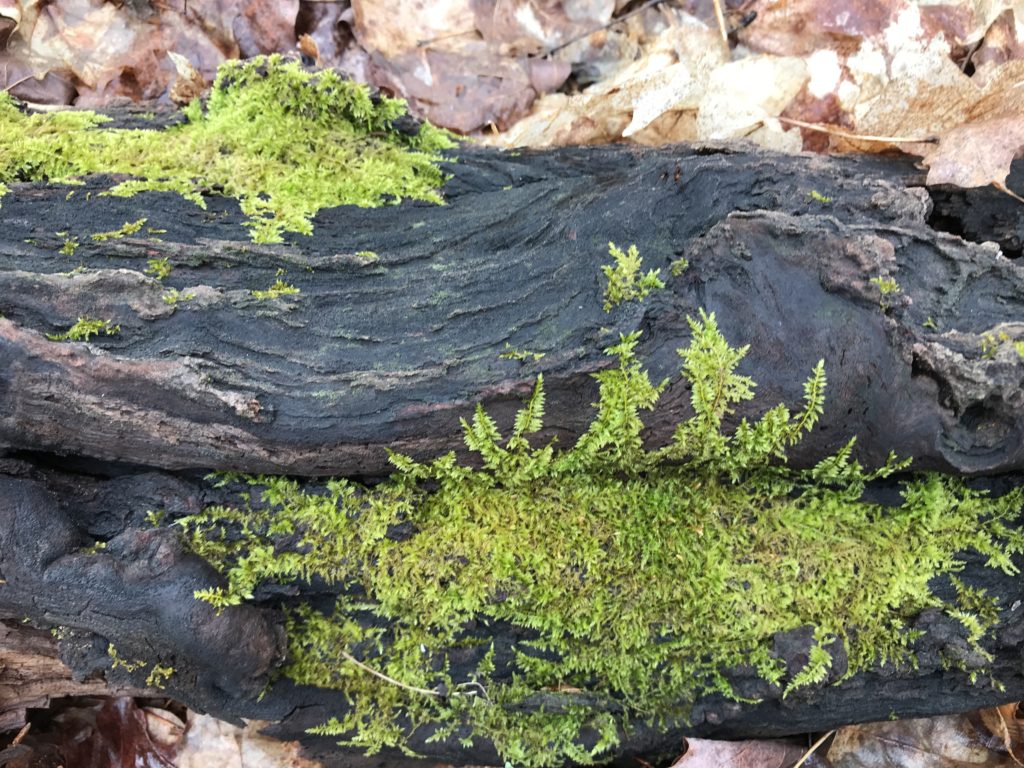
Cedar River Preserve, What’s Next?
Please Note: The new Cedar River Preserve 80-acre addition is not yet open to the public. As has been our practice with all natural areas, access is provided as soon as we can develop a management plan for the property that best preserves the land’s ecological resources and create safe, well-marked trails. Stay tuned for more information as plans unfold.
Become a steward of the land.
Help us preserve the wonders of Leelanau County by becoming a trail steward, volunteering at a workbee, or donating funds.
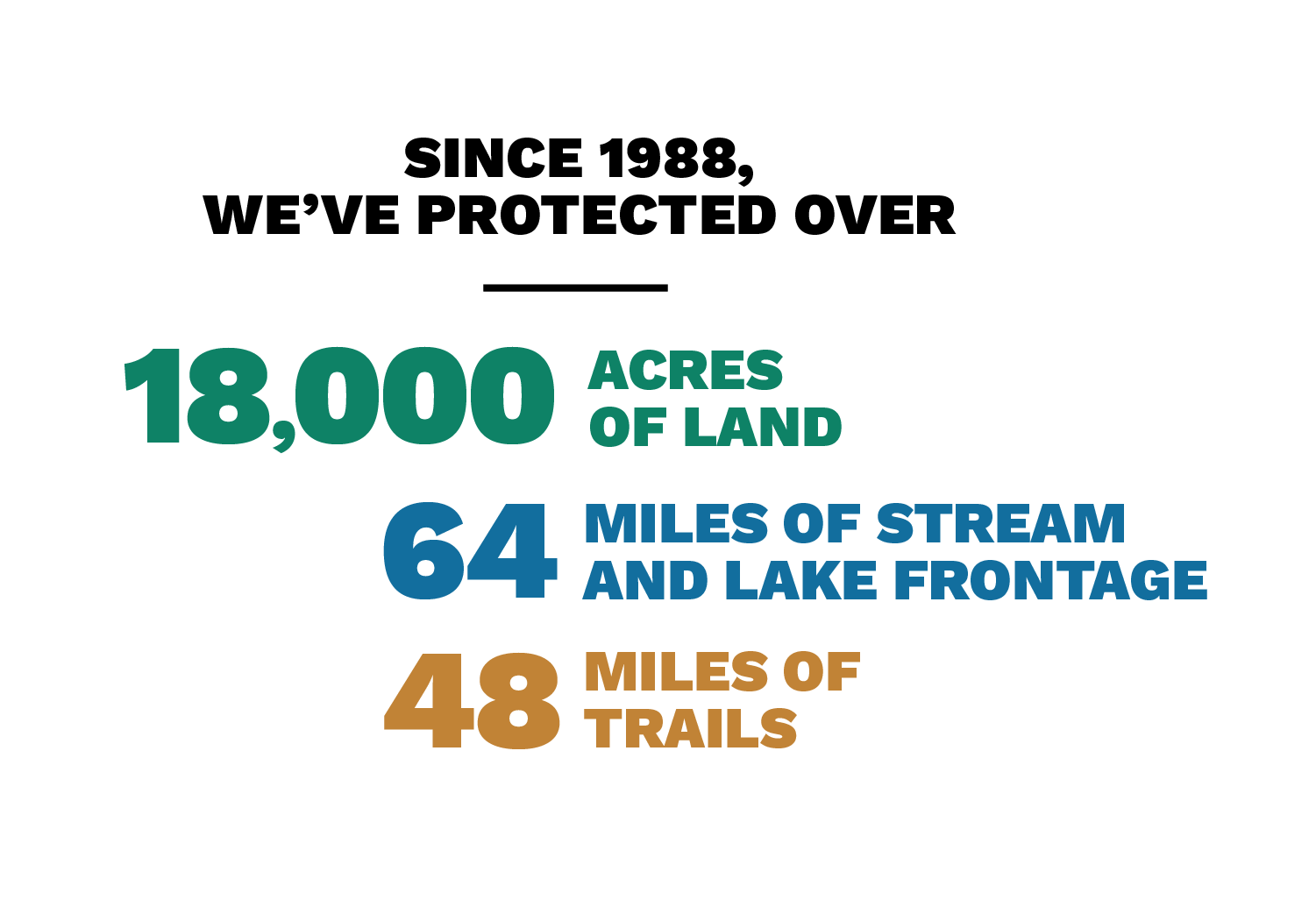
Greater Good Science Center • Magazine • In Action • In Education
How Nature Helps Us Heal
Here’s one silver lining to the pandemic: with gyms, museums, and stores closed, many of us were forced to spend more time outside. I was able to ditch my car and more safely pedal the 3.5 miles on pedestrian-friendly streets to work at Alta Bates Summit Medical Center in Oakland, where I work practicing hospital medicine.
One morning last spring, I was reflecting on how good the ride outside made me feel when I walked in to see a 68-year-old patient with several significant behavioral and medical problems.
Before I could say a thing, he jumped in as if in mid-conversation. “Dr. Hass, I can’t thank you enough. I swear that prescription you gave me mid-COVID lockdown saved my life!”

Nodding, I tried to hide the fact I didn’t recognize him; I assumed he was talking about an antibiotic or some other medicine.
“I was so depressed and isolated,” he said. “You gave me a prescription to ride my bike to the marina and watch the sunset. I have been watching that sunset almost every day until I got sick last week. And the prescription is still on the fridge! I can’t thank you enough!”
That rang a bell. I have been giving out old-school paper prescriptions for about two years now, where I prescribe non-pharmaceutical steps that have been proven to make people healthier. Apparently, I had given him one to get outside and take in the natural beauty of the sunset.
“Thank you, Mr. T.,” I said. “That means a lot to me, and your feedback really helps!”
I had heard that nature can make people happier and healthier, but, embarrassingly, I envisioned it for more “outdoorsy” people like me, whatever that means. Also, I assumed it would offer just a slight bump in the happiness quotient.
Mr. T. had shown me that I had underestimated both the impact of getting outside and who could be helped. As a result, I became determined to dig a little deeper to understand the health benefits so I could do more with these prescriptions.
Nature is good for us
Luminaries like Charles Darwin, Henry David Thoreau, Virginia Woolf, and Albert Einstein have written eloquently about the benefits of taking in the natural world. Frederick Law Olmsted, the 19th century architect of many great American parks, captured the experience well:
Nature employs the mind without fatigue and yet enlivens it. Tranquilizes it and enlivens it. And thus, through the influences of the mind over body, gives the effect of refreshing rest and reinvigoration to the whole system.
It took almost 150 years, but science has verified that statement almost word for word, including by researchers associated with the Greater Good Science Center. While much of the research has been done in the U.S., Japan is where the science has been most readily embraced. Starting with research on blood pressure and stress hormone levels in the early 2000s, there is now a medical specialty in forest bathing—an activity in which more than a quarter of Japanese partake. There are nearly 100 officially sanctioned forest baths where the benefits have been demonstrated, with guides to help visitors get the most from their time. In Japan, the director of the ministry of forestry is a social scientist, not a botanist, which hints at the country’s commitment to health-through-nature. Trees are seen more as a mental health resource than one that can be extracted for profit.
What are the benefits? According to research : lower blood pressure, heart rate, and stress; improved mood and immune function; better sleep; and increased creativity. There are surprising social benefits, too. During early forest bathing experiments, physician Qing Li found that after a couple hours in the woods, blood pressure went down an average of five points. The effects didn’t end once people left the trees; stress hormones were measurably lower for a week. After three days with two hours of forest bathing, markers of immune health showed improvement that lasted a week. And, of course, almost all the people said they just felt better, too!
We are primarily visual creatures, so it is not surprising that simply looking at beautiful natural scenes makes us feel good. A heart surgeon at Vanderbilt suspected it did more than that. Looking at it closely, he found that his patients whose hospital room faced the forest healed faster than those who faced the parking garage. I never knew why hospitals are full of nature scenes until I researched for this project. Strange that this bit of data reached the architects, but not the doctors! Nature is, of course, an all-senses experience. It’s not just about looking at the trees—you can smell them, too, and hear the wind in their branches, and touch their bark. Li’s group found that when people slept overnight breathing in essential oil from the Japanese cedar tree, they reported better sleep and had lower stress hormone levels. Since then, researchers at Vanderbilt have demonstrated nurses report less stress if this same oil is infused in their hospital workplace.
Sound researcher Joshua Smyth at Penn State has found that when people listen to songbirds, the tension in their nervous systems falls, as measured by heart rate variability; but tension increases with the rumble of cars and roar of airplanes. Researchers with the Nation Park Service found their parks “look” worse when people hear human-made sounds. That kind of urban noise can be more than an irritant: Research in Bonn, Germany, found that kids at schools subject to a lot of airplane noise have a tougher time learning than those in schools across town.
Why nature is good for us
So, why is the natural world good for us?
The biophilia theory suggested that since we evolved in nature, our senses and body rhythms are best suited for that environment. According to biologist E. O. Wilson, there is an “innate emotional affiliation with other living organisms” that makes us calm and comfortable in nature. The sounds, smells, sights are our evolutionary “happy place” where we can rest and rejuvenate. We are deeply tied to a world from where we have strayed. Despite the comforts and safety of the modern world, there is a price to pay for urban living.
Other scientists espouse something called the attention restoration theory. Rachel Kaplan at the University of Michigan says “soft fascination” with the beauty and mystery of the natural world draws us in. Nature, she says, is “enticing but not demanding.” Neuroscience research by her student Stephen Kaplan shows that looking at nature pictures let the hard-working executive function parts of the brain recover, compared to looking at urban landscapes.
Emotion scientists like the GGCS’s own Dacher Keltner believe there is something else going on as well: awe .
That’s the feeling we get from encountering something vast and wondrous, that challenges our comprehension. In an awed state, our jaw drops and we get goosebumps. But more than that, we have the same physiological effects we see in forest bathing, where heart rate and blood pressure drop. Beyond the physiological, there are prosocial effects to awe: less concern for self, increased generosity, and more cooperation. This might be why research suggests there is less violence when trees are incorporated into low-income housing developments.
What a prescription looks like
Researchers from Finland suggest that five hours a month is the minimum to have lasting effects (though you should leave the technology behind, or at least keep it in your pocket). It doesn’t have to be the forest; water, even urban parks, can be healing, too.
For those with the resources, I prescribe breaks to a quiet cabin or tent for at least three days, once or twice a year. I also recommend house plants for home and office, microbreaks where you stop work to look out the window, or a couple short walks even if it is in an urban environment. If all else fails, there are always nature videos , which have been shown to have positive effects. A walk with a friend outside is a Greater Good “three-fer”: exercise, friendship, and nature all at once.

A way to lift yourself out of the mundane
Access to the natural world is far from equitably distributed. While green space is foundational in public health and urban planning, my country, the United States, is far behind Japan, Korea, Singapore, and many European countries in efforts to integrate this idea into our society.
I see the effects of this lack of access every day. Last week, I was taking care of Ms. S., a 58-year-old woman with mental health and mobility issues complicated by poor social support. She came to the hospital with abdominal pain. Sitting down and talking to her, I could see her mood and isolation were her biggest issues.
Notes in her medical record recommended psychiatric care and medications, but I started with a different approach.
“What brings you joy, Ms. S.?”, I asked.
“Well, I loved my flower boxes I had outside my apartment,” she said. “I planted herbs and flowers. Tending the plants made me feel good, but the manager said it was a fire hazard and I have hardly been outside since they hauled them away.”
Her comments are in line with data on the benefits of touch—hands or feet in the dirt—and well-being. There is also a large body of research on the positive social and health benefits of gardening. Before she went home, our team gave her resources about community gardens, and I gave a prescription to bus to Redwood Park and the lake. While that felt insufficient, at least she felt buoyed by the idea that our health care team felt her garden was as important to her health as she did.
This is a lesson we all should learn from Ms. S.: Don’t underestimate the benefits of engaging with nature. Even if governments and institutions in the U.S. don’t get it yet, individuals can make a difference. Through efforts of hard-working citizens, vets can get outdoor therapy for PTSD . The SHINE program in the Bay Area is one of several park-health care collaboratives that get kids out of their city lives and into nature once a week. We should all be inspired by these efforts and find ways to advocate for green access as best we can.
Coming out of this long public health crisis, we should cherish all the good we can. I have tried to make this cognitive shift: Every episode outside is an opportunity to access the healing power of nature. I try to see each tree as an incredible living being and forests, the shoreline, and even my neighborhood park as sacred sites for communing with the wondrous natural world and restoring my body and mind. When I watch the sun set, I think of what it did for Mr. T.
About the Author

Leif Hass, M.D. , is a family medicine doctor and hospitalist at Alta Bates Summit Medical Center in Oakland. He serves as a Joy of Work Champion for Sutter Health and as a clinical instructor with UCSF.
You May Also Enjoy

What Happens When We Reconnect With Nature

How Being in Nature Can Spur Personal Growth

How Modern Life Became Disconnected from Nature
Why you need more nature in your life.

Why Is Nature So Good for Your Mental Health?
How nature can make you kinder, happier, and more creative.
The Positive Effects Of Nature On Your Mental Wellbeing
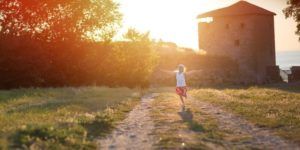
Just a walk in the woods or a stroll by the beach on a sunny morning can awaken the innermost feelings of happiness and peace, and Environmental Psychology has gone a long way proving this fact (Bell, Greene, Fisher, & Baum, 1996).
Our affinity toward nature is genetic and deep-rooted in evolution. For example, have you ever wondered why most people prefer to book accommodations that have a great view from the balcony or the terrace? Why patients who get a natural view from their hospital bed recover sooner than others? Or why does it happen that when stress takes a toll on our mind, we crave for time to figure out things amidst nature?
Frank Lloyd Wright had said, “ Study Nature, love Nature, stay close to Nature. It will never fail you. ” This article investigates the human-nature relationship in detail. Why we feel so empowered when we are close to Nature?
What happens to us when the soft breeze or the warm sun touch us? With research-backed evidence and useful environment-support hacks, this piece explores and acknowledges the sheer boon of the ‘Nature Contact’.
Before you read on, we thought you might like to download our three Positive Psychology Exercises for free . These science-based exercises will explore fundamental aspects of positive psychology including strengths, values and self-compassion and will give you the tools to enhance the wellbeing of your clients, students or employees.
This Article Contains:
A look at the positive effects of connecting with nature, a look at the psychology of environment, 4 examples of nature in psychology, what does the research say, 5 interesting studies.
- The Importance of Nature To Wellbeing
The Relationship Between Nature And Human Health
5 proven benefits of being in nature, a brief look at psychoevolutionary theory, attention restoration theory, 5 ways to apply the positive effects of nature in our life, a take-home message.
Author Richard Louv mentioned ‘Nature-Deficit Disorder’ in his famous book ‘ Last Child In The Woods .’
According to Louv, nature-deficit disorder is not the presence of an anomaly in the brain; it is the loss of connection of humans to their natural environment. Staying close to nature improves physical, mental, and spiritual wellbeing. It makes us feel alive from the inside, and we should not compromise it for recent developments like urbanization, technology, or social media (Louv, 2015).
As mentioned above, the benefits of staying close to nature are diverse. We can enjoy the positive effects of connecting to the environment at all levels of individual wellbeing.
Let’s see how:
Nature impacts health
- Forest bathing, or Shinrin-yoku , as they call it in Japan, is a famous way of spending time in nature. Research has shown that people who practice forest bathing have optimum nervous system functions, well-balanced heart conditions, and reduced bowel disorders (Mao et al., 2012).
- Outdoor activities reduce the chances of developing eyesight problems like hypermetropia and myopia. A survey conducted on children in Australia revealed that school-aged kids who participated in outdoor activities had better vision than kids who spent more time indoors (Rose et al., 2008a).
- Studies have related nature connections to lower BMI. People who exercise outdoors are less fatigued and have fewer chances of suffering from obesity and related conditions (Wolch et al., 2011).
- The Forest Bathing research also suggested that by stimulating the production of anti-cancer proteins, frequent walks or trips into the wilderness help patients in fighting terminal diseases. Although this is ongoing research and firmer evidence are awaited, this suggestion is strong enough to prove the benefits of being outdoors (Mao et al., 2012).
Nature improves psychological wellbeing
- Nature helps in emotional regulation and improves memory functions. A study on the cognitive benefits of nature found that subjects who took a nature walk did better on a memory test than the subjects who walked down the urban streets (Berman, Jonides, & Kaplan, 2008).
- Nature walks benefit people suffering from depression. Studies had shown that people suffering from mild to major depressive disorders showed significant mood upliftments when exposed to nature. Not only that, but they also felt more motivated and energized to recover and get back to normalcy (Berman et al., 2012).
- Recent investigations revealed that being outdoor reduces stress by lowering the stress hormone cortisol (Gidlow et al., 2016; Li, 2010).
- Nature walks and other outdoor activities build attention and focus (Hartig, Mang, & Evans, 1991). There are pieces of evidence that indicate strong environmental connections to be related to better performance, heightened concentration, and reduced chances of developing Attention Deficit Disorder (Faber Taylor & Kuo, 2009).
- A study at the University of Kansas found that spending more time outdoors and less time with our electronic devices can increase our problem-solving skills and improve creative abilities (Atchley, Strayer, & Atchley, 2012).
Spiritual enhancement
- Environmental psychologists have argued that there is a value component added to the human-nature relationship. By staying close to nature, we feel more grateful and appreciative of what it has to offer to us (Proshansky, 1976).
- Seeing the wonders of the world outside automatically fosters within us the urge to protect it.
- Breathing in nature gives us wholesome sensory awareness. When we spend time outdoors, we are more mindful of what we see, what we hear, what we smell, and what we feel (Howell et al., 2011).

It is the offshoot of brain science that focuses on the relationship living beings (especially humans) have with nature and studies the dynamics of the person-environment coexistence.
The psychology of the environment is a relatively contemporary concept. It emerged as a branch of psychology following research by Proshansky and colleagues on person-place interactions in the 1970s.
Environmental psychology is rooted in the belief that nature has a significant role in human development and conduct. It believes that nature has a vital contribution to the way we think, feel, and behave with others.
A fascinating story of the role of nature in shaping human behavior was mentioned in Marco Polo’s diary. It said that in 1272 when Polo was traveling through the different parts of Western Asia, he noted that the people of Kerman were polite, humble, and well-behaved, while the people in Persia, which was in the neighborhood, were cruel, unkind, and threatful (Spencer & Gee, 2009).
When exploring the reason for this stark behavioral difference, the people said that it was the ‘soil’ that was responsible for it. And as the story goes, when the King ordered soil from Isfahan in Persia and kept it in his banquet hall, his men started to shower each other with curse words and assaulted their folks.
Environmental psychology is for the most part problem-oriented. It aims to bring to notice the ongoing hazards and the faltering human-nature connections that we need to address.
By identifying the problem areas, it opens ways for solution-focused research and explorations. The psychology of nature and environment continuously facilitate climatic moderation. It also digs into the ways we can change the physical environment that we live in, to feel more connected and coexisting with nature.
Environmental psychology promotes healthy natural ecosystem and suggests how malfunctions in habitat have and will continue to affect human behavior, demographic variants, and the society as a whole.
Basic tenets of the psychology of environment
The psychology of environment works around the following main ideas (Gifford, 2007).
- Human dependence on nature validates evolution. We are more adaptive to natural settings than human-made habitats.
- Contact with natural light is therapeutic and has immediate positive effects on stress, blood pressure, and immune system.
- Strong connections to the environment enhance the person-space idea and increase environmental perception.
- Humans are always capable of improving the environment they live in.
- Humans are active adapters to changes in society and the environment. They reshape their social identities and affiliations according to the physical space they live in.
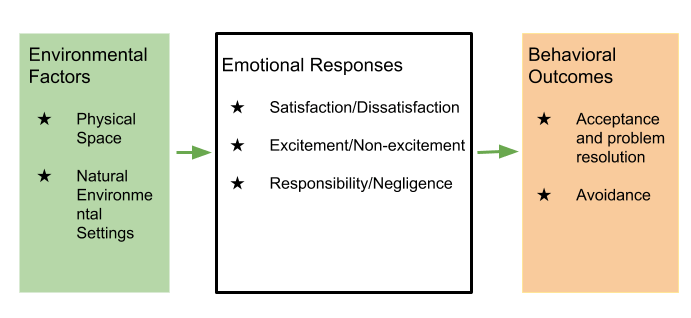
Nature has a deep-rooted meaning in psychology that encompasses the core components of our existence, including our genes. The popular nature-nurture concept in developmental psychology explores all the variables that shape and influence the relationship that our internal (personality traits and genetic factors) and external worlds (physical environment that we live in) share.
The Biophilia Hypothesis delved into the human relationship with nature in 1984. The concept was initially used by German psychoanalyst Erich Fromm who described biophilia as the ‘ love for everything that is alive .’ The idea of biophilia was later expanded by American biologist Edward O. Wilson, who proposed that the human inclination towards nature has a genetic basis (Rogers, 2019).
1. Stress and nature
A large-scale experiment conducted on 120 subjects ascertained the ‘nature-connection’ in stress reduction and coping. Each participant observed visuals of either a natural landscape or an urban environment. The data obtained from this survey revealed that participants who looked at the picture of natural setting had low scores on stress scales and had better heartbeat and pulse counts (Ulrich et al., 1991).
Furthermore, investigators also found that the stress recovery rate was much higher in participants who got a natural exposure than the ones who saw urbanized ambiances. The flow of this study strongly indicated the role nature plays in improving our general mental health conditions, including stress (Ulrich et al., 1991).
2. Nature for building attention
The fact that staying close to nature improves focus and attention span, was suggested in the Attention Restoration Theory by Rachel and Stephen Kaplan (1989). The theory explains why staying close to nature re-energizes us and reduces fatigue.
Encounters with any aspect of the natural environment – sunset, beach, clouds, or forests grab our positive attention without us paying much effort to it, and the whole process restores the life energy that negative emotions had taken away from us.
3. Climate crisis and denial
An immensely significant example of nature in human psychology is the research on climate crisis or climate change.
Climate crisis and global warming are international concerns today, and some psychologists argue that the impact of climate change is so vast and unimaginable, that we often choose not to respond to it.
Nevertheless, the effect of climate change on human psychology and mental health is well-established now. Studies show that climate change over the years has had a dramatic impact on the way we think, behave, decide, and execute plans (Lorenzoni, Pidgeon, & O’Connor, 2005).
The Australian Psychological Society has provided some mind-boggling figures . At the time of writing, they estimate 5-8% of the population across the US, UK, and Australia denies that climate change is happening, while 97% of climate scientists accept the fact and are concerned about it.
However small the denial rate may seem, researchers suggest that it is enough to create a judgment gap that may cause people to doubt their contribution behind the climatic adversities. No matter which direction the judgment travels, it is undeniable that climate crisis has and will continue to impact human minds in some way or the other.
4. Psychology, values, and nature
An experiment conducted on the landowners on Pennsylvania disclosed that staying close to nature adds a sense of value toward the self, others, and toward Mother Nature.
It builds connectivity and lets the way for gratitude and appreciation.
Results showed that respondents who had higher connectivity with nature and spent more time outdoors were more environmentally responsible, concerned, and happier in their interpersonal relationships (Dutcher, Finley, Luloff, & Johnson, 2007).

The Human-Nature Relationship And Health
The research paper on ‘ Human-Nature Relationship And Its Impact On Health: A Critical Review’ explores all the aspects of the interconnection we have with nature and how it affects our general health and wellbeing (Seymour, 2016).
Author Valentine Seymour (2016) defined our relationship with nature in close association with Darwinian principles of Evolutionary psychology . The study explained concepts of evolutionary biology, social economics, psychology, and environmentalism and scouts how the interplay of all these influence human health. The interdisciplinary research model suggests that:
- Staying close to nature improves physical conditions like hypertension, cardiac illness, and chronic pain.
- A strong connection to the natural environment enhances emotional wellbeing and alleviates feelings of social isolation. Besides, it also helps individuals suffering from mental health conditions like attention disorders, mood disorders, and different forms of anxiety.
- Nature-friendly people are more environmentally conscious and responsible. They have a rational sense of using their physical space and are more proactive to enact on issues that might help in sustaining the environment they live in.
A Multi-Disciplinary Study On Human-Nature Relationship
The multi-disciplinary HNC (Human-Nature Connection) study was a vast exploration of the kinetics involving the relatability we bear with our physical environment and also why many people are still unaware about the benefits of staying close to nature (Ives et al., 2017).
The study included a heap of psychometric assessments and personal interviews, and the results obtained by Ives et al. (2017) provided a strong lineup of why the human-nature connection is vital for human life and sustainability.
The University Of Tasmania Study On Nature And Affective Experience
David Hayward published this thesis in 2016 and studied the effect of nature connection with enhanced mental health conditions in students.
With strong evidence and research-backed examples, he suggested that teaching students from a broad perspective is way more effective than showing them only the subject matter (Knapp, 1989).
He studied the implications of outdoor education and concluded that kids who received outdoor training were more satisfied and emotionally well-balanced.
Not only that, outdoor educators, according to the researcher, were possessors of sound mental health and loved their jobs more than teachers in a controlled setting. The study attracted many educational sectors and have encouraged educators and facilitators to embrace outdoor activities as an integral part of educational courses.

Download 3 Free Positive Psychology Exercises (PDF)
Enhance wellbeing with these free, science-based exercises that draw on the latest insights from positive psychology.
Download 3 Free Positive Psychology Tools Pack (PDF)
By filling out your name and email address below.
We found that only four studies were not enough to mention, as there have been so many different and interesting approaches. Here is another five interesting studies.
1. A Study On Climatic Conditions And Its Effects On Personality Traits
A team of psychologists in the US, UK, China, and Australia investigated how climatic changes affect human personality. The study aimed to examine and explore the aetiological causes of why character and behavioral patterns differ with climatic variations (Wei et al., 2017).
The sample population for the research were individuals from China and the US, two different places in terms of climatic conditions, and the report explained personality variances concerning the Big Five Personality Factor Theory .
Results indicated that people who lived in a moderate climate, with temperature up to 22-24 degrees, score higher on personality traits such as sociableness, openness, extraversion, and agreeableness. This study was a basic authentication of the fact that the physical environment we live in plays a crucial role in shaping our personality disposition, and why there should be more awareness about protecting the Nature from mayhem.
2. A Study On Nature And Human Emotions
Scientists Ryan Lumber, Miles Richardson, and David Sheffield published a research paper in 2017 focused on the affective components of associating with nature. The authors suggested that being close to nature evokes positive emotions (Lumber et al., 2017).
Outdoor activities such as hiking, gardening, or birdwatching, enhance the nature-human connection and acts as a catalyst to happiness. The study used the Nature Relatedness Scale and recorded responses on a basic Likert Scale.
The results culminated from the study positively correlated outdoor experiences with positive emotions and expanded HNC (Lumber et al., 2017).
3. Climate Change And Its Effect On Human Personality
Charles Q. Choi (2017) published an enthralling paper on how global warming and climate crisis is expected to bring about changes in human behavior and personality traits.
The researcher argues that if climate has a role to play in framing our dispositions, then it is only logical to believe that the climate crisis and the changes that follow will also impact human mannerisms significantly.
The research-based explanations and pieces of evidence of this paper, has raised questions that are yet to be answered by experts.
4. Psychological Changes Associated With Living In The Polar Areas
This study was published by Zimmer et al., in 2013 and discussed how life in polar regions might impact the physical and mental wellbeing of the residents.
The study, besides establishing facts about being in the Poles, also firmly ascertained that we could not escape human-nature connection when talking about mental health and wellbeing.
The research suggested that geographically isolated regions of Antarctica are highly prone to get affected by climatic variations and global setbacks (Bradbury, 2002).
The lack of sunlight and extreme weather conditions in these regions impact cognitive functioning, anxiety levels, and causes a static low mood condition for its inhabitants (Paul, Mandal, Ramachandran, & Panwar, 2010a; Paul, Mandal, Ramachandran, & Panwar, 2010b).
5. Nature And Spirituality
The prime focus of research done by Professor Lockhart (2011) was to spread awareness about human disconnection from nature and explain why we must reconstruct this to promote happiness.
Investigator of this study, Prof Lockhart, indicated that the socio-ecological crisis the world is seeing today is due to this breach of connection between humans and nature. She highlights in her study that there is a spiritual enhancement that is linked to the human-nature relationship.
Each encounter with the natural environment takes us deeper into exploring the truth behind our existence and what a happier world would look like. The subject matter of this study was that materialistic gains has blindfolded us and has made us spiritually bankrupt (Okri, 2008).
Furthermore, the research also indicated that since humans are genetically conditioned to stay in close coexistence with nature, an absence of nature-human connection creates a sense of loneliness and unhappiness within us.
It is this feeling of gloom, as the researcher suggests, that is the reason for societal disruptions and human immorality today, and while we may seek for answers outside, the real solution lies in the nature-human relationship.
The Importance of Nature to Wellbeing
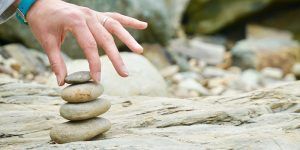
The study revealed that subjective feelings of happiness and wellbeing were positively correlated with natural activities such as gardening, animal feeding, bird watching, and bushwalking (Richardson, Cormack, McRobert, & Underhill, 2016).
Dr. Miles Richardson, the face of this research, cited valuable evidence on how proximity to the nature improved mood, enhanced respiratory functioning, regulated hormonal malfunctions, and impacted on the thought structure of individuals as a whole.
Just by being outdoors and using all our senses to appreciate nature, we can be more mindful of the present, gain emotional resilience, and combat stress with more vitality.
We become naturally immune to anxiety, emotional ups and downs, and thought blocks, thereby feel more lively and energetic than before.
The survey further pointed that people who lived close to natural wilderness like the beach, mountains, or parklands, had better mental health and reported of falling sick lesser than those living in congested urban settings.
Such families had fewer instances of domestic violence, said of feeling less fatigued, and showed increased productivity at the professional front.
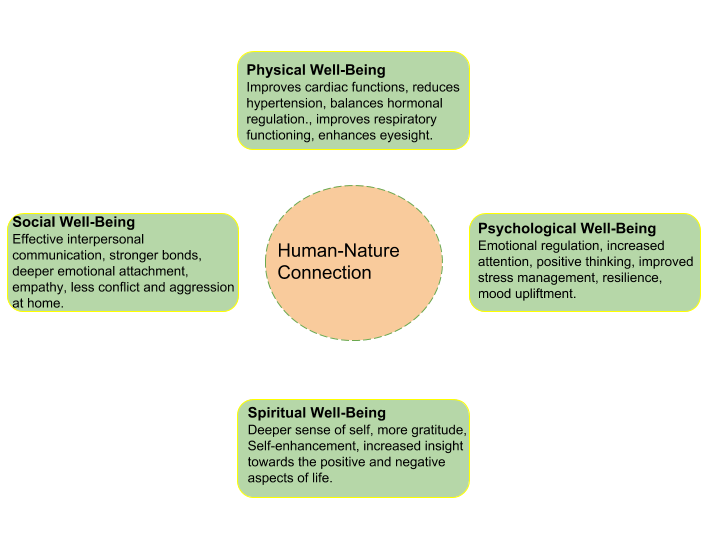
A recent survey report launched by scholars out of Deakin University (Maller et al., 2009) demonstrated some practical points as to how human and nature are entwined with each other.
Although the study had other focal areas and did not concentrate on a massive global sample, the report that came out was used and shared widely by environmental psychologists and social scientists to explain the relationship we have with our physical habitat.
The major assertions of this report were:
- Staying close to greeneries such as farms, parks and fields increase chances of related outdoor activities (walking, gardening, farming, playing, etc.). This improves mental health and physical fitness in adults and children who live there.
- Nature-friendly urban settings can be useful in promoting social connections and interpersonal communication.
- Contact with nature in any form enhances spiritual health and fills the mind with a deeper insight into life.
- Children who are encouraged to spend more time outdoors are owners of good physical and mental health. They are less prone to problems like obesity, asthma, childhood anxiety, and depression, and are more focused on their lives than others.
- Adolescents who had a close connection to nature were emotionally well-balanced and had better coping skills than other children of their age.
- Aged people, who had access to green parks felt more positive and hopeful.

Sir David Attenborough, one of the most popular nature enthusiasts the world has seen in a long time, had fairly quoted that
“We must cherish the natural world because we’re a part of it and we depend on it.”
It is difficult to gauge the benefits we can derive from being close to nature. Be that on the mind, body, or the soul, it leaves a lasting positive impression on every single aspect of our existence.
1. Nature provides
A day out in the sunshine can suffice us with vitamin D, a nutrient we don’t get from food as much we need it.
The right level of Vitamin D in the body immunes us against diseases like osteoporosis, cancer, diabetes, and Alzheimer’s. Besides, it also ensures the smooth functioning of the immune system.
Studies have indicated that a large chunk of the population today is deficient of the ‘sunshine vitamin,’ which explains the massive increase in fatal diseases today, and rather than relying on human-made supplements, a close connection to nature can help in replenishing the deficit (Naeem, 2010).
2. Nature improves
Computer Vision Syndrome (CSV) is a condition that arises from staring at the screen for prolonged hours. Naturally, such exposures take a toll on our eyesight and develop problems like dry eyes, myopia, or chronic headaches.
Spending time outdoors, especially in the greeneries is the best natural solution to this. Looking at the green grass, the trees, the flowers, and all the other aspects of the environment improve focus and eyesight.
Interestingly, studies have shown that children who spend more than four hours a day in the outdoors are four times less likely to develop eyesight problems than children who spent less than one hour outdoors every day (Rose et al., 2008b).
3. Nature cleanses
The environment is a natural purifier. Spending some hours outdoors helps in releasing the toxins from our body and leave us all fresh and rejuvenated.
The amount of bad air that we breathe in because of the pollution, industrial fumes, and indoor pollutants, is potent enough to dysregulate our respiratory tract, giving birth to breathing troubles, bronchitis, and asthma.
And there is no other solution to this except for spending more time in the natural environment and getting some fresh air every day.
4. Nature builds
Mostly, the time we spend outside involves physical activity in some form. It may be walking, jogging, cycling, diving, surfing, playing, or anything alike. Any exercise in the outdoors helps in burning fat and improves the metabolism rate in the body.
Research in this area has revealed that people who exercise outdoors enjoy their workout sessions more and are more likely to practice it regularly, than people who exercise indoors (Thompson Coon et al., 2011). Besides, outdoor activities are related to longer life span and fewer health problems.
5. Nature heals
“A walk in nature walks the soul back home.”
Nature is undoubtedly the best healer. Spending time in nature awakens our senses and provides clarity.
Many studies have proved that people who have a close connection to the landscapes are happier from the inside – they indulge themselves in positive thinking and have better coping mechanisms than others.
A strong human-nature relationship means emotional balance, more focus, solution-oriented thinking, and an overall resilient approach to life.
The Psychoevolutionary Theory is built on the proposition that our personality, actions, and thoughts are shaped genetically by natural selection.
Roger Ulrich (1984), the face of this theory said that humans have a deep-rooted affinity towards nature, which is due to the thousands of years that early humans had spent living amid the wild landscapes. It is due to this fact that staying close to nature brings a feeling of positivity and happiness in us.
Furthermore, the PET (Psychoevolutionary Theory) asserted that staying in a human-made environment invites disorders like stress, depression, obesity, and cardiac diseases, and is a challenge to our overall wellbeing (Ulrich & Simons, 1986).
Spending long hours indoors is likely to bring negative thoughts and fatigue. Through extensive research and survey, scientists have proved that when we feel low and less energetic, an encounter with the natural elements can instantly make us feel better (Zuckerman, 1977).
The psychoevolutionary model of Ulrich (1983) suggested that:
- Staying close to nature is a genetically influenced preference of humans.
- Spending more time outdoors has a replenishing effect on emotions, memory, and cognition.
- Restraining oneself in enclosed artificial physical settings can evoke anger, despair, and depression – together affecting our wellbeing.
- Nature has an in-built restoration component that helps in stress reduction and emotional regulation.

The Attention Restoration Theory (ART) was proposed by Rachel Kaplan and Stephen Kaplan (1989) and reflected upon the gospel that staying close to the natural environment builds focus.
The proponents of the theory first mentioned about this in their book ‘The experience of nature: A psychological perspective ’ where they discussed how effortlessly witnessing natural phenomena like watching the leaves move, or the clouds float, make us more observant and attentive.
They identified two types of attention:
- Voluntary attention – where we willingly focus on something and spend our mental energy fully into internalizing the experience.
- Involuntary attention – where we unknowingly pay attention to something and get invested into that.
The ART suggests that any attention can be built and redeemed through exposure to natural settings. By establishing a strong connection to nature, we can stay away from everyday stressors, experience positivity and joy, regain intrinsic motivation, and become more aware of our sensory stimulations (Berman, Jonides, & Kaplan, 2008; Kaplan, 1995).
The theory indicates that nature has some ‘soft fascinations’ that help in restoring attention when we get distracted or mentally tied down. The soft fascinations are nothing but soothing natural elements (for example flowers, breeze, or gentle sunshine) that we all love to be close to. When we stay close to these pleasant aspects of nature, we do not have to put any effort into attending to it; we effortlessly immerse ourselves into the experience.
They bring feelings of pleasure and contentment, which is why people who spend more time in nature are more intuitive, energetic, and consciously attentive (Fuller et al., 2007; Keniger, Gaston, Irvine, & Fuller, 2013).
Several studies and large-scale surveys had been conducted to validate the theory and is still an intriguing area of research for environmentalists (Ohly et al., 2016).
Mycobacterium Vaccae: The Happy Bacterium?
The term Mycobacterium Vaccae originated from the Mycobacteriaceae , a type of soil bacteria and the Latin word Vacca, meaning ‘cow’ (as it was first found in a cow dung sample taken from Austria).
The reason for the popularity of this microorganism is because of the incredible links it has with health improvement and psychological wellbeing. Studies indicate that the Mycobacterium Vaccae, more commonly known as the ‘happy bacteria’ or the ‘happiness bacteria’ is useful for treating asthma, cancer, depression, phobia, dermatitis, and even tuberculosis.
A study conducted by O’Brien and colleagues (2004) explained how, by injecting the bacteria in patients with chronic lung disease, she made them recover faster and with a better prognosis. Besides, the research also suggested that using this microbe improves mood, induces positive emotions, and produces more vitality.
Another study headed by Dr. Christopher Lowry, a neuroscientist at the University of Bristol, explored the effect of the ‘Happiness Bacterium’ on stress and burnout by injecting the bacteria on mice and conducting a series of stress tests on them after that.
The results showed that the group of mice that received the Mycobacterium injections acted as if they were on antidepressants. But no such reaction was noticed in the group that did not receive the treatment. The research report indicated that the Mycobacterium Vaccae activates the neurotransmitters in the brain that release serotonin or the ‘happy hormone,’ resulting in inducing happiness and positivity (Lowry et al., 2007).
Besides boosting happiness, happy bacteria also makes us immune to flu, infections and gives a significant boost to brain functioning. Now we know why they say “ The dirtier the feet, the happier the heart. ”
The sun is shining, the flowers are blooming, and the air is getting warmer.
As the weather improves, we tend to spend more time outside, which is great for our physical and mental health.
Studies suggest that spending time in nature can have therapeutic benefits for our attentional capacities (Berto, 2005).
The Attention Restoration Theory (ART; Kaplan, 1995) explains how nature can restore our attention after working mentally.
Accordingly, our attentional system constitutes two separate systems. First, we engage in “directed attention” when we focus extensively on working tasks and disregard all other distractions. With repetition, we deplete our mental capacities and show a limited span of our attention.
On the other hand, spending time in nature increases effortless reflection, which is considered the secondary attentional system of ART (Kaplan & Berman, 2010). Frequent walks in nature help decrease stress and prevent burnout symptoms like attentional depletion (Passmore & Holder, 2016).
Taking walks in nature is a powerful way to increase your mood, decrease depressive symptoms and improve memory (Berman, Jonides & Kaplan, 2008).
Choose a natural area, such as a city park, for a peaceful and quiet walk. During the walk, attend to the smells, sounds, and sights surrounding you. Allow your mind to wander and appreciate the wonders of nature.
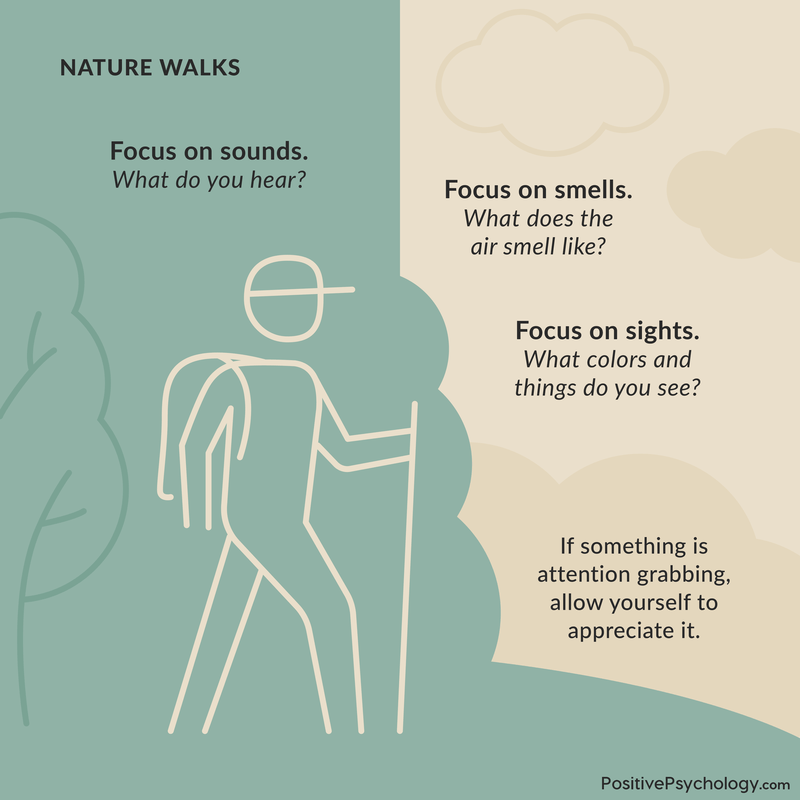
Although there are so many suggestions in this article, let’s focus on five practical options.
1. Walk more
We know walking is good for the heart, muscles, and the overall metabolism rate. And now scientists have proved that walking in the natural environment improves our emotional health too.
A study conducted and published by Stanford University, California revealed that participants who walked in the green parklands showed increased attention and focus, more so than participants who walked in closed urban settings or on a treadmill (Bratman, Daily, Levy, & Gross, 2015).
Not only that, but the former group also showed less engagement in negative thinking and felt more confident about themselves than the other group.
2. Keep a nature journal
A nature journal is a creative and unique way of imbibing the positive vibes of nature into our everyday lives. Many people who encourage this habit express feelings of inner peace and joy. In a nature journal, we can collect and note everything about our encounters with the outer world.
For example, after a walk by the beach on a cloudy evening, we can sketch some clouds in the journal or draw the sea and write how we felt when we were walking through the breezy shore. Many people collect small things like a pebble, flowers, feathers, or leaves, and glue them in the nature journal with their thoughts poured into it.
A great way to spend some quality ‘me-time,’ nature journaling inevitably brings a part of nature in our usual lives.
Watch this video to get started on nature journaling:
3. Spend some working hours outside
Most working professionals today have the flexibility to access daily tasks outside (thanks to technology). We can choose to spend a part of our working day out to avoid the monotony of the cubicle and the same old office space.
It may be one conference in the garden or lunch at the local park, anything that can logically amalgamates with nature. Spending some time outside alone or with co-workers gives an instant boost of freshness to the mind, thereby reducing the stress and frustration that comes from working tonelessly for hours at a stretch.
4. Plant at home
Growing plants at home not just add aesthetic beauty to your space, it also contributes to purifying the air you breathe in.
Having plants at home balances and soothes the home ambiance and aids in respiration and breathing. Studies have proved that indoor plants or a garden are beneficial for the mental health of the people who live there. They help in improving sensory awareness, cognitive functions, and enhances focus (Orwell et al., 2004).
Indoor plants reconnect us to nature, please our senses, and brings a serene feeling when we stay close to them.
5. Balance the diet with more natural elements
Diet is undoubtedly a great way of establishing a strong connection to Mother Nature. By consuming more plant-based proteins, vitamins, and minerals, we can help our body maintain its optimal state of functioning and homeostasis level.
Healthcare research proved that the consumption of plant-based protein is correlated to lower mortality rates as opposed to animal-based proteins (Song et al., 2016). It is not a bad idea, after all, to replace meat with vegetables and grains – if that brings good health and long life to us!

World’s Largest Positive Psychology Resource
The Positive Psychology Toolkit© is a groundbreaking practitioner resource containing over 500 science-based exercises , activities, interventions, questionnaires, and assessments created by experts using the latest positive psychology research.
Updated monthly. 100% Science-based.
“The best positive psychology resource out there!” — Emiliya Zhivotovskaya , Flourishing Center CEO
“All the trees are losing their leaves, and not one of them is worried.”
Donald Miller
Staying close to nature, observing all the little and significant elements of it, and appreciating it from the very core, is therapeutic and self-healing.
Even by saying and doing nothing, we can learn so much from connecting to our natural surroundings. It gives us the perspective for healthier living, the motivation to carry on, and the energy to keep trying. For there is no bond more primitive and ingrained in us than our love for nature and nature’s care for us.
We hope you enjoyed reading this article. Don’t forget to download our three Positive Psychology Exercises for free .
- Atchley, R. A., Strayer, D. L., & Atchley, P. (2012). Creativity in the wild: Improving creative reasoning through immersion in natural settings. PloS one, 7 (12).
- Bell, P. A., Greene, T. C., Fisher, J. D., & Baum, A. (1996). Environmental psychology (4th ed.). New York, NY: Harcourt.
- Berman, M. G., Jonides, J., & Kaplan, S. (2008). The cognitive benefits of interacting with nature. Psychological Science, 19 (12), 1207-1212.
- Berman, M. G., Kross, E., Krpan, K. M., Askren, M. K., Burson, A., Deldin, P. J., … & Jonides, J. (2012). Interacting with nature improves cognition and affect for individuals with depression. Journal of Affective Disorders, 140 (3), 300-305.
- Berto, R. (2005). Exposure to restorative environments helps restore attentional capacity. Journal of Environmental Psychology, 25(3) , 249-259
- Bradbury, J. (2002). Utter isolation in a cold climate: The Antarctic challenge. The Lancet, 359 (9312), 1130.
- Bratman, G. N., Daily, G. C., Levy, B. J., & Gross, J. J. (2015). The benefits of nature experience: Improved affect and cognition. Landscape and Urban Planning , 138 , 41-50.
- Choi, C. Q. (2017, November 27). Could climate change affect people’s personalities? Live Science . Retrieved from https://www.livescience.com/61033-climate-temperature-personality.html
- Dutcher, D. D., Finley, J. C., Luloff, A. E., & Johnson, J. B. (2007). Connectivity with nature as a measure of environmental values. Environment and Behavior, 39 (4), 474-493.
- Faber Taylor, A., & Kuo, F. E. (2009). Children with attention deficits concentrate better after walk in the park. Journal of Attention Disorders , 12 (5), 402-409.
- Fuller, R. A., Irvine, K. N., Devine-Wright, P., Warren, P. H., & Gaston, K. J. (2007). Psychological benefits of greenspace increase with biodiversity. Biology Letters , 3 (4), 390-394.
- Gidlow, C. J., Randall, J., Gillman, J., Smith, G. R., & Jones, M. V. (2016). Natural environments and chronic stress measured by hair cortisol. Landscape and Urban Planning , 148 , 61-67.
- Gifford, R. (2007). Environmental psychology: Principles and practice . Colville, WA: Optimal books.
- Hartig, T., Mang, M., & Evans, G. W. (1991). Restorative effects of natural environment experiences. Environment and Behavior, 23 (1), 3-26.
- Hayward, D. C. E. (2016). Students’ affective experience of connection with nature: An Australian university case study (doctoral thesis). University of Tasmania, Launceston.
- Howell, A. J., Dopko, R. L., Passmore, H., & Buro, K. (2011). Nature connectedness: Associations with well-being and mindfulness. Personality and Individual Differences, 51(2), 166-171.
- Ives, C. D., Giusti, M., Fischer, J., Abson, D. J., Klaniecki, K., Dorninger, C., … & Raymond, C. M. (2017). Human–nature connection: A multidisciplinary review. Current Opinion in Environmental Sustainability, 26 , 106-113.
- Kaplan, S. (1995). The restorative benefits of nature: Toward an integrative framework. Journal of Environmental Psychology , 15 (3), 169-182.
- Kaplan, S., & Berman, M. G. (2010). Directed attention as a common resource for executive functioning and self-regulation. Perspectives on Psychological Science, 5(1) , 43-57.
- Kaplan, R., & Kaplan, S. (1989). The experience of nature: A psychological perspective. Cambridge, UK: Cambridge University Press.
- Keniger, L. E., Gaston, K. J., Irvine, K. N., & Fuller, R. A. (2013). What are the benefits of interacting with nature?. International Journal of Environmental Research and Public Health , 10 (3), 913-935.
- Knapp, C. (1989). Humanizing outdoor education: Exploring the affective domain. Journal of Physical Education, Recreation & Dance, 60 (2), 40-43.
- Li, Q. (2010). Effect of forest bathing trips on human immune function. Environmental health and preventive medicine, 15(1), 9–17.
- Lockhart, H. (2011). Spirituality and nature in the transformation to a more sustainable world: Perspectives of South African change agents (doctoral thesis). Stellenbosch University, Stellenbosch.
- Lorenzoni, I., Pidgeon, N. F., & O’Connor, R. E. (2005). Dangerous climate change: the role for risk research. Risk Analysis: An International Journal, 25 (6), 1387-1398.
- Louv, R. (2005). Last Child in the Woods: Saving our children from nature-deficit disorder . Algonquin Books.
- Lowry, C. A., Hollis, J. H., De Vries, A., Pan, B., Brunet, L. R., Hunt, J. R., … & Rook, G. A. (2007). Identification of an immune-responsive mesolimbocortical serotonergic system: Potential role in regulation of emotional behavior. Neuroscience , 146 (2), 756-772.
- Lumber, R., Richardson, M., & Sheffield, D. (2017). Beyond knowing nature: Contact, emotion, compassion, meaning, and beauty are pathways to nature connection. PloS one, 12 (5).
- Maller, C., Townsend, M., St Leger, L., Henderson-Wilson, C., Pryor, A., Prosser, L., & Moore, M. (2009). Healthy parks, healthy people: The health benefits of contact with nature in a park context (2nd ed.). Burwood, VIC: Deakin University.
- Mao, G. X., Lan, X. G., Cao, Y. B., Chen, Z. M., He, Z. H., Lv, Y. D., Wang, Y. Z., Hu, X. L., Wang, G. F., & Yan, J. (2012). Effects of short-term forest bathing on human health in a broad-leaved evergreen forest in Zhejiang Province, China. Biomedical Environmental Science . 25(3):317-24.
- Naeem, Z. (2010). Vitamin deficiency-an ignored epidemic. International Journal of Health Sciences , 4 (1), 5-6.
- O’Brien, M. E. R., Anderson, H., Kaukel, E., O’Byrne, K., Pawlicki, M., Von Pawel, J., & Reck, M. (2004). SRL172 (killed Mycobacterium vaccae) in addition to standard chemotherapy improves quality of life without affecting survival, in patients with advanced non-small-cell lung cancer: Phase III results. Annals of Oncology , 15 (6), 906-914.
- Ohly, H., White, M. P., Wheeler, B. W., Bethel, A., Ukoumunne, O. C., Nikolaou, V., & Garside, R. (2016). Attention Restoration Theory: A systematic review of the attention restoration potential of exposure to natural environments. Journal of Toxicology and Environmental Health, Part B , 19 (7), 305-343.
- Okri, B. (2008, October 30). Our false oracles have failed. We need a new vision to live by. The Times . Retrieved from https://www.thetimes.co.uk/article/our-false-oracles-have-failed-we-need-a-new-vision-to-live-by-nm6qdm6nzzp
- Orwell, R. L., Wood, R. L., Tarran, J., Torpy, F., & Burchett, M. D. (2004). Removal of benzene by the indoor plant/substrate microcosm and implications for air quality. Water, Air, and Soil Pollution , 157 , 193-207.
- Passmore, H. A., & Holder, M. D. (2016). Noticing nature: Individual and social benefits of a two-week intervention. Journal of Positive Psychology, 11(5) , 525-534.
- Paul, F. J., Mandal, M. K., Ramachandran, K., & Panwar, M. R. (2010a). Cognitive performance during long-term residence in a polar environment. Journal of Environmental Psychology , 30 (1), 129-132.
- Paul, F. J., Mandal, M. K., Ramachandran, K., & Panwar, M. R. (2010b). Interpersonal behavior in an isolated and confined environment. Environment and Behavior , 42 (5), 707-717.
- Proshansky, H. M. (1976). Environmental psychology and the real world. American Psychologist , 31 (4), 303-310.
- Richardson, M., Cormack, A., McRobert, L., & Underhill, R. (2016). 30 days wild: Development and evaluation of a large-scale nature engagement campaign to improve well-being. PloS one , 11 (2).
- Rogers, K. (June 25, 2019). biophilia hypothesis. Encyclopedia Britannica . https://www.britannica.com/science/biophilia-hypothesis.
- Rose, K. A., Morgan, I. G., Ip, J., Kifley, A., Huynh, S., Smith, W., & Mitchell, P. (2008a). Outdoor activity reduces the prevalence of myopia in children. Ophthalmology, 115 (8), 1279-1285.
- Rose, K. A., Morgan, I. G., Smith, W., Burlutsky, G., Mitchell, P., & Saw, S. M. (2008b). Myopia, lifestyle, and schooling in students of Chinese ethnicity in Singapore and Sydney. Archives of Ophthalmology , 126 (4), 527-530.
- Seymour, V. (2016). The human-nature relationship and its impact on health: A critical review. Frontiers in Public Health, 4 .
- Song, M., Fung, T. T., Hu, F. B., Willett, W. C., Longo, V. D., Chan, A. T., & Giovannucci, E. L. (2016). Association of animal and plant protein intake with all-cause and cause-specific mortality. JAMA Internal Medicine , 176 (10), 1453-1463.
- Spencer, C. & Gee, K. (Feb 25, 2009). The roots and branches of environmental psychology . The British Psychological Society.
- Stokols, D., & Altman, I. (1987). Handbook of environmental psychology (Vol. 2). New York, NY: Wiley.
- Thompson Coon, J., Boddy, K., Stein, K., Whear, R., Barton, J., & Depledge, M. H. (2011). Does participating in physical activity in outdoor natural environments have a greater effect on physical and mental wellbeing than physical activity indoors? A systematic review. Environmental Science & Technology , 45 (5), 1761-1772.
- Ulrich, R. S. (1983). Aesthetic and affective response to natural environment. In I. Altman & J. Wohlwill (Eds.), Behavior and the natural environment (pp. 85-125). Boston, MA: Springer.
- Ulrich, R. S. (1984). View through a window may influence recovery from surgery. S cience , 224 (4647), 420-421.
- Ulrich, R. S., & Simons, R. F. (1986). Recovery from stress during exposure to everyday outdoor environments. In Proceedings of EDRA (Vol. 17, pp. 115-122).
- Ulrich, R. S., Simons, R. F., Losito, B. D., Fiorito, E., Miles, M. A., & Zelson, M. (1991). Stress recovery during exposure to natural and urban environments. Journal of Environmental Psychology , 11 (3), 201-230.
- Wei, W., Lu, J. G., Galinsky, A. D., Wu, H., Gosling, S. D., Rentfrow, P. J., … & Gui, W. (2017). Regional ambient temperature is associated with human personality. Nature Human Behaviour, 1 (12), 890-895.
- Wolch, J., Jerrett, M., Reynolds, K., McConnell, R., Chang, R., Dahmann, N., Brady, K., Gilliland, F., Su, J. G., & Berhane, K. (2011). Childhood obesity and proximity to urban parks and recreational resources: a longitudinal cohort study. Health & place, 17(1), 207–214.
- Zimmer, M., Cabral, J. C. C. R., Borges, F. C., Côco, K. G., & Hameister, B. D. R. (2013). Psychological changes arising from an Antarctic stay: Systematic overview. Estudos de Psicologia (Campinas) , 30 (3), 415-423.
Share this article:
Article feedback
What our readers think.
What an excellent article! So thorough, and lays out all the evidence to support the idea that exposure to nature is good for us – something I strive to account for in my architecture practice. Thank you.
I would have to say for so many kindness can save their day They could be lost they can find their way Make the most out of each day Thinking before expressing what did I say I can’t believe I can do that I know its wrong that’s a human fact I’m supposed to love not attack I shouldn’t always look behind my back No one is playing games with me Perhaps one day my vision they’ll clearly see Its not cool to make others think of fear and complete dispair When you yourself maybe in a state of disrepair There’s hope for something good to happen to anyone Do good works and you’ll be happy when your done Life can be rewarding life can be fun Share that simple sentence with someone
Nice article. Feel to go through again and again.
This IS a nice article. What a perfect justification for our outdoor classroom! 🙂
Let us know your thoughts Cancel reply
Your email address will not be published.
Save my name, email, and website in this browser for the next time I comment.
Related articles

The Science of Sleep: 7 Secrets for Better Wellbeing
Sleep is at once highly familiar—we all do it—and deeply mysterious; among those studying the science of sleep, there is no consensus on why it [...]

The Hidden Costs of Sleep Deprivation & Its Consequences
In the short term, a lack of sleep can leave us stressed and grumpy, unwilling, or unable to take on what is needed or expected [...]

Circadian Rhythm: The Science Behind Your Internal Clock
Circadian rhythms are the daily cycles of our bodily processes, such as sleep, appetite, and alertness. In a sense, we all know about them because [...]
Read other articles by their category
- Body & Brain (51)
- Coaching & Application (58)
- Compassion (25)
- Counseling (51)
- Emotional Intelligence (23)
- Gratitude (18)
- Grief & Bereavement (21)
- Happiness & SWB (40)
- Meaning & Values (26)
- Meditation (20)
- Mindfulness (44)
- Motivation & Goals (45)
- Optimism & Mindset (34)
- Positive CBT (30)
- Positive Communication (22)
- Positive Education (47)
- Positive Emotions (32)
- Positive Leadership (19)
- Positive Parenting (16)
- Positive Psychology (34)
- Positive Workplace (37)
- Productivity (18)
- Relationships (44)
- Resilience & Coping (39)
- Self Awareness (21)
- Self Esteem (38)
- Strengths & Virtues (32)
- Stress & Burnout Prevention (34)
- Theory & Books (46)
- Therapy Exercises (37)
- Types of Therapy (64)
3 Positive Psychology Tools (PDF)
The Healing Power of Nature

I t sounded more like a lark than a scientific study when a handful of Japanese researchers set out to discover whether something special–and clinically therapeutic–happens when people spend time in nature. They were inspired by a new recommendation from the Forest Agency of Japan, which in the early 1980s began advising people to take strolls in the woods for better health. The practice was called forest bathing, or shinrin-yoku, and it was believed to lower stress–but that hadn’t been proved. Since then, a large body of evidence has shown that spending time in nature is responsible for many measurable beneficial changes in the body.
In one early study, Yoshifumi Miyazaki, a forest-therapy expert and researcher at Chiba University in Japan, found that people who spent 40 minutes walking in a cedar forest had lower levels of the stress hormone cortisol, which is involved in blood pressure and immune-system function, compared with when they spent 40 minutes walking in a lab. “I was surprised,” Miyazaki recalls. “Spending time in the forest induces a state of physiologic relaxation.”
Another researcher, Dr. Qing Li, a professor at the Nippon Medical School in Tokyo, found that trees and plants emit aromatic compounds called phytoncides that, when inhaled, can spur healthy biological changes in a manner similar to aromatherapy, which has also been studied for its therapeutic benefits. In his studies, Li has shown that when people walk through or stay overnight in forests, they often exhibit changes in the blood that are associated with protection against cancer, better immunity and lower blood pressure.
Recent studies have also linked nature to symptom relief for health issues like heart disease, depression, cancer, anxiety and attention disorders.
“The quiet atmosphere, beautiful scenery, good smells and fresh, clean air in forests all contribute to the effects,” says Li.
1 IT CAN LOWER BLOOD PRESSURE
Spending time outside is good for the heart, research shows, and since high blood pressure costs the U.S. approximately $48.6 billion per year and affects 1 in 3 Americans, visiting green spaces may be a simple and affordable way to improve heart health. A large June 2016 study found that nearly 10% of people with high blood pressure could get their hypertension under control if they spent just 30 minutes or more in a park each week. “If everyone were to make time for nature, the savings on health care costs could be incredible,” says study author Danielle Shanahan, a research fellow at the University of Queensland in Australia.
The fresh air could be one factor, since air pollution has been linked to a higher risk for heart attacks, but since the study participants lived in cities (and therefore were also being exposed to air pollution), that likely isn’t the only driver. Scientists think stress reduction also plays a part. “Nature is undemanding,” says Shanahan. “It requires effortless attention to look at the leaves of a tree, unlike the constant emails at work or the chores at home.”
Trees’ natural fragrance may also play a role, as some studies have shown that phytoncides lower blood pressure by quelling the body’s fight-or-flight response, which stresses the body.
2 EXPOSURE TO IT CAN INCREASE AWE
Looking at a stunning waterfall or undulating countryside can do more than enrich your Instagram feed: it can also elicit feelings of awe that bring a number of health benefits. In a 2015 study, researcher Paul Piff of the University of California, Irvine, found that people who spent 60 seconds looking up at towering trees were more likely to report feeling awe, after which they were more likely to help a stranger than people who looked at an equally tall–but far less awe-inspiring–building.
“Experiences of awe attune people to things larger than themselves,” says Piff. “They cause individuals to feel less entitled, less selfish, and to behave in more generous and helping ways.” The benefits of awe are physical too: regularly experiencing moments of awe has been linked to lower levels of inflammatory compounds in the body.
Everyday interactions with nature can also benefit. An April 2016 study of 44 cities found that urban areas with more parks scored higher on measures of community well-being. That’s likely because parks give people opportunities to socialize and be active with their neighbors, which could improve health, the researchers say. People in cities with lots of green space were more likely to report having more energy, good health and a sense of purpose too.
3 IT PROMOTES CANCER-FIGHTING CELLS
An April 2016 study published in the journal Environmental Health Perspectives reported that women living in areas with a lot of vegetation had a 12% lower risk of death from all causes compared with people in the least green places. That could be thanks to cleaner air, but nature may also offer its own medicine. Li’s research at Nippon Medical School shows that when people walk through a forest, they inhale phytoncides that increase their number of natural killer (NK) cells–a type of white blood cell that supports the immune system and is associated with a lower risk of cancer. NK cells are also thought to have a role in combating infections and autoimmune disorders and tamping down inflammation, which contributes to a wide range of ailments, including heart disease and diabetes.
In a 2010 study, researchers found that people who took two long walks through forests on consecutive days increased their NK cells by 50% and the activity of these cells by 56%. Those activity levels remained 23% higher than usual for the month following the walks. In another study, Li and his co-authors found that infusing people’s hotel rooms with phytoncides had some of the same anti-cancer-cell effects as those seen among people walking through forests.
4 IT CAN HELP WITH DEPRESSION AND ANXIETY
Not surprisingly, urban dwellers are far more likely to have anxiety and mood disorders than people who live in rural areas. That’s the bad news, since about 80% of Americans live in cities. The good news is that a small 2015 study published in the Proceedings of the National Academy of Sciences found that people who walked for 90 minutes in a natural setting, such as a forest or a nature park, were less likely to ruminate–a hallmark of depression and anxiety–and had lower activity in an area of the brain linked to depression than people who walked in an urban area. “Accessible natural areas may be vital for mental health in our rapidly urbanizing world,” the study authors write.
The exact mechanism of how nature helps mood disorders is unclear, but researchers agree that at the very least, time in nature tends to lift spirits. “When you have a short blast of nature exposure, people’s moods go up,” says Ming Kuo, an environment and behavior scientist at the University of Illinois at Urbana-Champaign. Another possibility is that the air near moving water, forests and mountains contains high levels of negative ions, which are thought to potentially reduce depression symptoms, according to a study in Frontiers in Psychology.
5 IT MAY HELP WITH ADHD SYMPTOMS
Small studies in kids with attention-deficit/hyperactivity disorder (ADHD) have suggested that nature walks could be a potential natural treatment to improve attention. In one study, a team led by Kuo of the University of Illinois at Urbana-Champaign had kids with ADHD take three 20-minute walks, without their medication, in different locations: a park, a neighborhood and an urban area. When the researchers tested the children afterward, they found that after a park walk, the kids were able to concentrate substantially better than after a walk in the other settings. In a separate 2011 study, Kuo and her colleagues found that children who regularly played in outdoor areas had milder ADHD symptoms, according to their parents, than children who played indoors or in areas with less nature access. “Nature gives the part of the brain that’s used in effortful concentration a rest,” says Kuo. “If you spend time doing something mentally relaxing, you feel rejuvenated.”
People without ADHD symptoms can also improve their attention and concentration by interacting with nature, evidence suggests. One University of Michigan study found that people improved their short-term memory by 20% after a nature walk but had no changes after walking through city streets.
6 EVEN FAKE NATURE HAS BENEFITS
Before you start planning your escape to the countryside, consider this: “There is plenty of evidence that you will get a range of benefits even if all you can manage is putting a plant in your room or looking at trees through your window at home,” says the University of Queensland’s Shanahan.
Research shows that even if they’re artificial, the images, sounds and smells of nature can have positive health effects. Listening to nature sounds over headphones, for instance, has been shown to help people recover faster from stress–which might explain why so many spas employ nature sounds in their treatment rooms.
Several studies have also shown that having a window view can improve attention, reduce stress and even help people in hospitals heal after operations. One widely cited study of people recovering from abdominal surgery found that those with tree-lined views were released faster from the hospital, experienced fewer complications and required less pain medication than people whose rooms faced a brick wall.
More Must-Reads from TIME
- How Joe Biden Leads
- There's Something Different About Will Smith
- What Animal Studies Are Revealing About Their Minds—and Ours
- How Private Donors Shape Birth-Control Choices
- What a Hospice Nurse Wants You to Know About Death
- 15 LGBTQ+ Books to Read for Pride
- TIME100 Most Influential Companies 2024
- Want Weekly Recs on What to Watch, Read, and More? Sign Up for Worth Your Time
Contact us at [email protected]
- Newsletter Signup

The Healing Power of Nature
- January 28, 2022

Luis Gallardo
The goal of life is living in agreement with nature. – Zeno
Picture this: You are standing in the street, surrounded by tall buildings, traffic, noise, and concrete. Not too relaxing of an image, right? Now, picture this: blue skies, bird’s song, tall trees bending on the gentle wind, and soft grass under your feet. Even just by visualizing it, your body can feel the benefits of nature. The tension in your jaw and muscles slowly subsides, the headache that’s been bothering you all morning starts to calm down, and the emotional pressure goes away – if only for a couple of precious moments. This is the power of nature.
The connection between nature exposure and our health is as old as time. However, it is only recently in human evolution that we started living apart from nature, in our cities and megalopolis’. Researchers are now slowly catching up, trying to showcase actual causality between nature exposure and our health. Although we could say that we’ve always known this fundamental truth, it seems like we are just starting to realize it as we’re waking from our concrete slumber.
The Benefits of Natural Surroundings on Human Health
Whether going out for a walk or meeting a friend in a park, you can feel the health benefits of being outdoors. Soothing breezes, lush bushes and trees, and warm sun on your face naturally make you feel good. Even a simple physical activity as a walk around your block can nourish your senses when you’re in a mindful state. The sight of clouds and flowers and the beautiful sound of birds singing can calm your spirit and bring back inner peace and balance.
We humans have always been interested in the healing power of nature. There are numerous philosophical works, books, poems, and songs about nature’s beauty and its effect on our bodies, minds, and souls. One of the most famous nature gurus, Henry David Thoreau, has famously said: ‘There are moments when all anxiety and stated toil are becalmed in the infinite leisure and repose of nature.’ He fully understood nature’s power to heal, sensing that the forest, or any other natural setting, can quiet our minds and improve our health. Almost two centuries later, there is plenty of evidence on the healing power of nature to back him up.
Spending time in nature can be incredibly beneficial for our health. Just two hours spent in nature per week can reduce stress, improve overall feelings of happiness and well-being, combat depression, raise our energy level and even increase our capacity for caring. Recent discoveries have, in fact, shown that nature’s ability to heal both our physical and mental health and the health of our communities can happen in such small spaces as a neighborhood park, green schoolyard, or a community garden. This is good news for millions of people living in metropolitan areas whose daily lives can only bring them into contact with such modest versions of nature.
Health Benefits of Nature
Nature is a powerful force when it comes to healing our minds, bodies, and spirits. It helps us feel connected to one another, ourselves, and the wonder of our natural world. Nature can:
Boost our mood – Stepping outside into the warmth of a sunny day can almost instantly bring a smile to our face, and there is a perfectly good reason for that. Sunlight provides us with nourishing and energizing vitamin D, which has been known to boost our mood, calm the nervous system and improve such issues as a seasonal affective disorder. Vitamin D also promotes calcium absorption, which can minimize the risk of cancer, hypertension, and certain autoimmune diseases.
It keeps us in the present – Unplugging from our daily lives and getting a nature fix allows us to focus on the now. When in nature, we can quiet our minds and take in the sights, smells, and sounds that surround us, fully experiencing the present moment. Just this basic form of meditation in a natural environment, where we focus on the present rather than dwelling on the past or worrying about the future, can substantially minimize stress and anxiety levels in our bodies.
It can energize us – While you may think a shot of espresso or an energy drink can help you get over an afternoon slump, a simple walk in the woods is a far better option. I’m not just saying this. In fact, a series of studies published in the Journal of Environmental Psychology has shown that people who were exposed to the natural environment for just 20 minutes a day experienced elevated energy levels and better overall mood than those who stayed at home!
It can make us kinder – A study done by the University of Rochester has shown that people tend to be more kind, feel more generous, more connected to their communities, and be more socially conscious when exposed to nature. Surprisingly enough (or not!), even simply looking at photos of nature would reinforce feelings of connection with other living things, which in turn would remind people of fundamental values like generosity and caring.
It can strengthen our spirituality – There is a deeply spiritual side to connecting with nature which can provide us with a stronger sense of self. Although we are a part of the universe larger than we can even imagine, that doesn’t mean we can’t find comfort in the vast and awe-inspiring environment around us. Nature can help us reconnect by doing something as simple as dipping our toes in the ocean or walking barefoot over grass in our backyard.
Back to Nature
Considering the state of the world now is more important than ever to set aside any reluctance or judgment and finally walk among the trees or listen to the waves with bare feet in the sand, not just to heal ourselves but also to heal the earth. Perhaps the most positive thing that came out of this pandemic is how it forced people worldwide to realize that we are leading nature starved lives and that our wellness depends on the wellness of our planet.
The air was starting to clean up as the traffic decreased, global emissions dropped dramatically, the waters in bays and rivers began clearing, and consumerism and competition became obsolete as we collectively understood that our health and wellness were our real treasure. If we take the earth’s healing seriously, we will also take our own health seriously, and what better time to connect to our planet and ourselves to support this healing than now?
Continue to Part 2 of the Series on The Healing Power of Nature
What are you looking for?
World happiness fest 2023, you might like also.

Embracing Lokahi: Connecting Sacred Hawaiian Wisdom to Universal Happiness
In the rich tapestry of Hawaiian culture, the concept of

From Sustainability to Regeneration: Pioneering Regenerative Happiness
In recent years, the concept of sustainability has been at

Happiness as a Verb: Embracing a Multidimensional Approach
In our pursuit of a fulfilling life, we often consider

- Our Partners
- Become a partner

- Global Expeditions
- Training and Education
- Become a member

- World Happiness Week
- Central Stage
- Digital summit
- The Future of Work
- Conscious Kids Fest
- Get involved
- Power of Belonging Summit

- Nominations
- Public vote

- Global Agoras
- The World HappinessXchange
- Become an Agora Host
- Emotional support
Observatory
- My Happiness page
- World Happiness blog
- The happiness podcast

World Happiness Foundation Inc. is a not-for-profit 501(c)3 incorporated in Florida, USA. 10275 Collins Avenue. 33154
- +1 347-606-5317
We'll keep you updated on new and meaningful discoveries

Environment
How nature heals, the benefits of forest bathing..
Posted November 19, 2020 | Reviewed by Kaja Perina
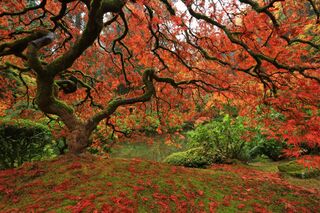
Among all their marvels, trees are good listeners. They stand silently and courteously, holding space for all our thoughts — the happy ones and the sad ones. They’ve learned mercy, they’ve earned wisdom , from observing life unfold. They’ve seen and heard it all. Sometimes, they will let the wind chime in. Leaves will whisper. Branches will nod. Birds will offer their good sense. Beetles will poke their curious heads out of cracked bark and damp soil. But the trees, unperturbed and dignified, will keep listening to our stories, even before we put them into words.
For thousands of years, humans have turned to Nature for their ailments. By now, the benefits of pulling away from the grip of our stressful , urban lifestyles and stepping into the arms of Nature are well documented by science. Take, for example, the growing popularity of shinrin yoku or forest bathing. In recent years, countless forest-goers around the world have been enjoying the therapeutic effects of this Japanese practice. Whether they come in groups or alone, in Europe or in Asia — the forests reward their visitors. As writer John Muir penned, “In every walk with Nature one receives far more than he seeks.”
As a forest therapy practitioner from Ireland, Shirley Gleeson regularly witnesses some of these well-being effects firsthand. Gleeson sees her role as a facilitator, helping her clients establish a deep connection with Nature. Her biggest lesson, she tells me, is to know when to get out of the way and let Nature do its work. “I may have a whole outdoor session planned and the group just wants to lie in the moss or sit with a tree,” she says.
At first glance, forest bathing might look similar to the leisurely Nature visits you indulge in on sunny weekends. It’s the same walk, along the same trails, with the same hiking shoes strapped on your feet. But there is a twist: The roles between you and the forest are reversed. Now, you are the listener. Now, you are the one offering the woods your doting presence. It’s usually the treetops that keep an eye over you as you trudge through labyrinths of ancient roots and pass by the rumbling creek that lives between the straight-spined pines, barely touched by their grace.
Now, you are there, truly there, to hear the trees and to taste the air.
What happens next?
After initial self-consciousness, forest-bathers appear to let go of their everyday roles and just be , observes Gleeson. The sights, smells, and sounds of the forest might bring up happy childhood memories of possibilities and imagination . Various emotions might arise — playfulness, joy, creativity , sometimes even sadness from the realization that “they had not laid on the forest floor or felt the rain on their faces since they were children,” notes Gleeson. Overall, as mental chatter subsides and clarity settles, her group leaves the forest “lighter, smiling, and rejuvenated.”

On the other side of the Earth, forest therapist Nagisa Ono invites her clients to engage all their senses as they take in the splendor of the Japanese forests. In the past 13 years, she has guided over 2000 people to experience the wonders of shinrin yoku . “The most important thing is to relax in the forest,” she says. That makes it easier to enjoy the forest as a multisensory feast. In the meantime, while our senses are absorbed in smelling, seeing, hearing, touching, tasting the Nature around us, a cascade of health benefits floods through our minds and bodies.
According to research , the benefits of forest bathing are far-ranging. For example, forest bathing has been shown to:
- Increase the activity and number of immune cells that are important for fighting viruses, bacteria, and even tumors. Studies show that higher levels of these “natural killer” cell activity is associated with reduced cancer risk.
- Reduce blood pressure and heart rate, thus have preventative effects on hypertension
- Reduce blood glucose levels in type 2 diabetes patients
- Increase serums that have anti-tumorigenesis activity (adiponectin) and have cardioprotective and anti-obesity properties (DHEA-S)
- Balance the nervous system , by increasing the activity of the parasympathetic nervous system , and dampening the activity of the sympathetic nervous system
- Reduce stress hormones , such as adrenaline and cortisol
- Reduce anxiety , depression , anger , mental fatigue
- Increase vigor
- Improve creativity
- Improve sleep quality
- One of the mechanisms that facilitate these therapeutic benefits comes directly from the forest air itself. Phytoncides are volatile organic compounds that are exuded from trees and plants and act as protective agents against harmful insects. Inhaling these natural forest fragrances drives some of the positive effects of the forest on our physiological functioning.
Then there is the enchanting beauty of Nature.
“Sometimes it is like stepping into another world where time seems to slow down, and endless possibilities emerge,” says Gleeson. Entering “forest time” prompts our bodies to get attuned to the rhythms of Nature, Gleeson explains, calming and slowing our minds, refreshing our spirits. Perhaps that’s the secret of Nature that poets have urged us to embrace: patience.
If you are thinking of giving forest bathing a try, Gleeson has these practical tips:
- Turn off your phone
- Bring layers of clothing
- Go to the forest with an open mind and an open heart
- Engage all your senses
- Don’t get surprised if initially, some frustrations arise, especially if you are a very active person (slowing down can do that)
- Give yourself permission to take time out for yourself, without having to achieve any goals
- Let the forest do the work

Sometimes, the awe that the forest’s wilderness can evoke in humans is similar to that of the boundless, star-scattered night sky. There is a mystery in the presence of Nature’s majesty, an inkling of something bigger than ourselves, an awareness of not-knowing. But unlike other mysteries, Nature leaves us with profound feelings of belonging. For Ono, that — the fact that we are part of Nature — is the biggest lesson from the forest.

In a way, then, standing with the trees, listening to the birds, smelling the pines, touching the moss, tasting the moist air, is a homecoming. And if you find yourself enthralled by the forest’s welcome, looking for ways to grasp on to the magic around you, keep in mind Ono’s gentle advice: “Try not to gain from the forest, but instead, to notice the changes within you.” Those changes might just be a sign that the magic has found you.
Many thanks to Shirley Gleeson and Nagisa Ono for their time and insights. Shirley Gleeson is a Nature & Wellbeing Consultant, the Director of Ecowellness Consulting Ltd. and the Co-Founder of the Forest Therapy Institute. Nagisa Ono is a Forest Therapist and the Executive Director of Future With Forest Association .
Li, Q., Morimoto, K., Nakadai, A., Inagaki, H., Katsumata, M., Shimizu, T., ... & Kagawa, T. (2007). Forest bathing enhances human natural killer activity and expression of anti-cancer proteins. International Journal of Immunopathology and Pharmacology , 20(2_suppl), 3-8.
Ideno, Y., Hayashi, K., Abe, Y., Ueda, K., Iso, H., Noda, M., ... & Suzuki, S. (2017). Blood pressure-lowering effect of Shinrin-yoku (Forest bathing): a systematic review and meta-analysis. BMC Complementary and Alternative Medicine, 17 (1), 409.
Li, Q., Morimoto, K., Kobayashi, M., Inagaki, H., Katsumata, M., Hirata, Y., ... & Kawada, T. (2008). Visiting a forest, but not a city, increases human natural killer activity and expression of anti-cancer proteins. International Journal of Immunopathology and Pharmacology, 21 (1), 117-127.
Park, B. J., Tsunetsugu, Y., Kasetani, T., Kagawa, T., & Miyazaki, Y. (2010). The physiological effects of Shinrin-yoku (taking in the forest atmosphere or forest bathing): evidence from field experiments in 24 forests across Japan. Environmental Health and Preventive Medicine, 15 (1), 18.
Ohtsuka, Y., Yabunaka, N., & Takayama, S. (1998). Shinrin-yoku (forest-air bathing and walking) effectively decreases blood glucose levels in diabetic patients. International Journal of Biometeorology, 41 (3), 125-127.
Morita, E., Imai, M., Okawa, M., Miyaura, T., & Miyazaki, S. (2011). A before and after comparison of the effects of forest walking on the sleep of a community-based sample of people with sleep complaints. BioPsychoSocial Medicine, 5 (1), 13.
Li, Q., Otsuka, T., Kobayashi, M., Wakayama, Y., Inagaki, H., Katsumata, M., ... & Suzuki, H. (2011). Acute effects of walking in forest environments on cardiovascular and metabolic parameters. European Journal of Applied Physiology, 111 (11), 2845-2853.
Kotera, Y., Richardson, M., & Sheffield, D. (2020). Effects of shinrin-yoku (forest bathing) and nature therapy on mental health: A systematic review and meta-analysis. International Journal of Mental Health and Addiction, 1-25.
Chen, H. T., Yu, C. P., & Lee, H. Y. (2018). The effects of forest bathing on stress recovery: Evidence from middle-aged females of Taiwan. Forests, 9 (7), 403.
Yu, C. P. S., & Hsieh, H. (2020). Beyond restorative benefits: Evaluating the effect of forest therapy on creativity. Urban Forestry & Urban Greening , 126670.
Imai, K., Matsuyama, S., Miyake, S., Suga, K., & Nakachi, K. (2000). Natural cytotoxic activity of peripheral-blood lymphocytes and cancer incidence: an 11-year follow-up study of a general population. The Lancet, 356 (9244), 1795-1799.
Li, Q. (2020). Introduction of forest medicine: Effects of forest bathing shinrin-yoku on human health. In Forests for Public Health (p. 2-30), edited by Gallis, C. & Shin, W.S. Cambridge Scholars Publishing.
Gleeson, S., O’Keeffe, D., Gesse, A., (2020). Feasibility and experience of a forest therapy intervention for adults enduring stress. In Forests for Public Health (p. 116-158), edited by Gallis, C. & Shin, W.S. Cambridge Scholars Publishing.

Marianna Pogosyan, Ph.D. , is a lecturer in Cultural Psychology and a consultant specialising in cross-cultural transitions.
- Find a Therapist
- Find a Treatment Center
- Find a Psychiatrist
- Find a Support Group
- Find Online Therapy
- United States
- Brooklyn, NY
- Chicago, IL
- Houston, TX
- Los Angeles, CA
- New York, NY
- Portland, OR
- San Diego, CA
- San Francisco, CA
- Seattle, WA
- Washington, DC
- Asperger's
- Bipolar Disorder
- Chronic Pain
- Eating Disorders
- Passive Aggression
- Personality
- Goal Setting
- Positive Psychology
- Stopping Smoking
- Low Sexual Desire
- Relationships
- Child Development
- Self Tests NEW
- Therapy Center
- Diagnosis Dictionary
- Types of Therapy

At any moment, someone’s aggravating behavior or our own bad luck can set us off on an emotional spiral that threatens to derail our entire day. Here’s how we can face our triggers with less reactivity so that we can get on with our lives.
- Emotional Intelligence
- Gaslighting
- Affective Forecasting
- Neuroscience
Thank you for visiting nature.com. You are using a browser version with limited support for CSS. To obtain the best experience, we recommend you use a more up to date browser (or turn off compatibility mode in Internet Explorer). In the meantime, to ensure continued support, we are displaying the site without styles and JavaScript.
- View all journals
- Explore content
- About the journal
- Publish with us
- Sign up for alerts
- Published: 01 November 2001
Nature's helping hand
- W. F. Bynum 1
Nature volume 414 , page 21 ( 2001 ) Cite this article
1835 Accesses
4 Citations
3 Altmetric
Metrics details

Six centuries ago, the Italian humanist and poet Petrarch remarked that if a hundred, or a thousand, people of the same constitution and illness were divided into two groups, one under medical care and one entrusted to nature, the latter would show more cases of recovery. For many years, popular wisdom held that “there is much difference between a good and a bad physician, but not any between a good physician and none at all”. In fact, L. J. Henderson, the famous Harvard biochemist, maintained that it was not until around 1910 that “a random patient, with a random disease, consulting a doctor chosen at random had, for the first time in the history of mankind, a better than fifty–fifty chance of profiting from the encounter”.
Such observations invite a range of responses. A cynic might remark that Henderson's favourable odds have yet to be achieved even today, but a more benevolent view of medicine's past would attribute much to sensible advice, pastoral care, a few good remedies and the placebo effect. Whatever one's view, however, the puzzle remains of how medicine survived as a social institution despite centuries of therapeutic impotence, incompetence and pernicious meddling.
The Hippocratic physicians identified one potential answer: the healing power of nature. Doctors, they taught, are merely nature's servants. They took their diagnostic and therapeutic cues from what they could observe at the bedside — sick people, especially patients suffering from acute illnesses, often sweat, vomit, have diarrhoea, are pale, flushed or jaundiced, cough up phlegm or blood, lose their appetites, and develop pustules or rashes. The Hippocratics interpreted these signs and symptoms as evidence that the body is a marvellous mechanism with an innate capacity to restore the natural humoral balance that constitutes health. Their ministrations were generally aimed at assisting and encouraging these natural processes.
This doctrine of the vis medicatrix naturae provided a rationale for much of the Hippocratics' activity. Inflamed limbs and fevered bodies turn red, clear evidence of too much blood. Why not therefore remove some through phlebotomy? Similarly, cathartics, emetics, sudorifics, diuretics and errhines were given to stimulate purging, vomiting, sweating, urination or nasal discharge, all frequent phenomena at the sickbed and presumably, therefore, part of the body's natural defences. To the Hippocratics, the art of medicine consisted of knowing when, and how much, to help — as well as when to stop.
Hippocratic humoralism dominated Western medical thinking until the eighteenth century. The doctrine of nature's healing power enjoyed reasonable assent, although its theoretical basis was reconceptualized by several doctors. In the seventeenth century, Jean Baptiste van Helmont saw healing as a manifestation of the workings of the archaeus, a vital principle that he located in the stomach. Johann Wepfer visualized it as a function of the 'president' of the nervous system, whereas Georg Stall believed that it was diffused throughout the whole body.
Running through much of this debate was the anxious suspicion that the doctrine rather minimized the role of the expert in the treatment of illness within an unregulated medical market-place. If nature knows best, why bother to consult a doctor? A typical attitude was that of John Conolly, who in 1859 acknowledged the power of natural healing, yet concluded that neither doctors nor their patients should ever “trust entirely to the vis medicatrix naturae , except in the case of the most trifling injuries, where a process of very small extent is all that is required for the cure”.
By Conolly's time, both the authority of Hippocrates and the doctrine of vis medicatrix naturae were being appropriated by several sectarian challenges to what Samuel Hahnemann, the founder of homeopathy, had called the allopathy (treatment by opposites) of traditional Western medicine. Most nineteenth-century medical sectarians — practitioners of homeopathy, chiropractic, hydropathy, osteopathy and naturopathy — called upon Hippocrates, the 'father of Western medicine', to sanction their endeavours. The originator of modern naturopathy, Benedict Lust (his modern followers are at pains to point out that his name is pronounced 'Loost'), was inspired by “natural therapies used successfully since ancient times” to create his own philosophy of health and the treatment of disease. Search the Internet for vis medicatrix naturae and you will find yourself in the land of what we now politely call 'alternative' or 'complementary' medicine.
Hippocrates has thus become the patron saint of virtually all occidental medicine, scientific or otherwise. This status rests squarely on the Hippocratic insight dubbed “the wisdom of the body” by W. B. Cannon. Readers of Nature may well seek the source of that wisdom in the biological mechanisms of evolutionary adaptations. Indeed, the modern scientific custodians of the Hippocratic doctrine are the advocates of darwinian medicine, who question whether it is wise to provide symptomatic relief for the multitude of self-limited illnesses to which our flesh is heir.
FURTHER READING
Neuburger, M. The Doctrine of the Healing Power of Nature Throughout the Course of Time (New York Homeopath. Coll., New York, 1932). Warner, J. H. The Therapeutic Perspective: Medical Practice, Knowledge, and Identity in America, 1820–1885 (Harvard Univ. Press, Cambridge, Massachusetts, 1986). Nesse, R. M. & Williams, G. C. Evolution and Healing (Weidenfeld & Nicolson, London, 1995).
Author information
Authors and affiliations.
Wellcome Trust Centre for the History of Medicine, University College London, 24 Eversholt Street, London, NW1 1AD, UK
W. F. Bynum
You can also search for this author in PubMed Google Scholar
Rights and permissions
Reprints and permissions
About this article
Cite this article.
Bynum, W. Nature's helping hand. Nature 414 , 21 (2001). https://doi.org/10.1038/35102123
Download citation
Issue Date : 01 November 2001
DOI : https://doi.org/10.1038/35102123
Share this article
Anyone you share the following link with will be able to read this content:
Sorry, a shareable link is not currently available for this article.
Provided by the Springer Nature SharedIt content-sharing initiative
This article is cited by
Descriptive modeling of the dynamical systems and determination of feedback homeostasis at different levels of life organization.
- G. N. Zholtkevych
- K. V. Nosov
- E. V. Vysotskaya
Acta Biotheoretica (2018)
Quick links
- Explore articles by subject
- Guide to authors
- Editorial policies
Sign up for the Nature Briefing newsletter — what matters in science, free to your inbox daily.
An official website of the United States government
The .gov means it’s official. Federal government websites often end in .gov or .mil. Before sharing sensitive information, make sure you’re on a federal government site.
The site is secure. The https:// ensures that you are connecting to the official website and that any information you provide is encrypted and transmitted securely.
- Publications
- Account settings
Preview improvements coming to the PMC website in October 2024. Learn More or Try it out now .
- Advanced Search
- Journal List
- Int J Environ Res Public Health

A Review of the Benefits of Nature Experiences: More Than Meets the Eye
Lara s. franco.
1 School of Biological Sciences, University of Queensland, Brisbane, QLD 4072, Australia; [email protected]
Danielle F. Shanahan
2 Zealandia Sanctuary, 31 Waiapu Road, Karori, Wellington 6012, New Zealand; [email protected]
Richard A. Fuller
Evidence that experiences of nature can benefit people has accumulated rapidly. Yet perhaps because of the domination of the visual sense in humans, most research has focused on the visual aspects of nature experiences. However, humans are multisensory, and it seems likely that many benefits are delivered through the non-visual senses and these are potentially avenues through which a physiological mechanism could occur. Here we review the evidence around these lesser studied sensory pathways—through sound, smell, taste, touch, and three non-sensory pathways. Natural sounds and smells underpin experiences of nature for many people, and this may well be rooted in evolutionary psychology. Tactile experiences of nature, particularly beyond animal petting, are understudied yet potentially fundamentally important. Tastes of nature, through growing and consuming natural foods, have been linked with a range of health and well-being benefits. Beyond the five senses, evidence is emerging for other non-visual pathways for nature experiences to be effective. These include ingestion or inhalation of phytoncides, negative air ions and microbes. We conclude that (i) these non-visual avenues are potentially important for delivering benefits from nature experiences; (ii) the evidence base is relatively weak and often based on correlational studies; and (iii) deeper exploration of these sensory and non-sensory avenues is needed.

1. Introduction
Experiences of nature provide people with multiple benefits to health and well-being, yet the mechanisms by which these benefits are delivered are not well understood [ 1 , 2 ]. Interest in nature as a therapeutic resource has ancient foundations. Hippocrates extolled the necessity of “airs, waters, and places”, for physical and mental well-being [ 3 ], and ancient Roman texts suggest that there are health benefits to countryside and greenspaces [ 4 ]. Gardens were prescribed for monasteries in the 1200’s “not only for food, but also for recreation in the open air to aid the recovery of the sick and to preserve health and improve those fatigued by their spiritual studies,” according to the Franciscan Minister General, Bonaventura, in 1260 [ 5 ]. In 1839, the Annual Report of the British Registrar General opined that, “a park in (the) East End would diminish annual deaths by thousands and add several years to the lives of the entire population” [ 4 ]. Overexposure to manmade environments was believed to cause “excessive nervous tension, over-anxiety, hasteful disposition, impatience and irritability” [ 6 ]. An early American illness known as neurasthenia with symptoms of depression, anxiety, insomnia, and migraines, was often cured with nature therapy, known as the “west cure”, where men (including prominent figures such as poet Walt Whitman, painter Thomas Eakins, novelist Own Wister, and US President Theodore Roosevelt) were sent west to ranches to work roping horses on the range [ 7 ]. The cure they suggested was simple: experiences of pleasant rural scenery. This idea has spawned an enormous volume of research on the visual appeal and restorative potential of natural landscapes [ 8 , 9 , 10 ]. However, emphasis is repeatedly placed on experiences of pleasant rural scenery . Perhaps as a result of vision being the dominant human sense, research has focused heavily on the visual benefits of nature experiences potentially at the expense of understanding the non-visual senses, and other pathways such as airborne volatile chemicals and the ingestion of microbiota. Emerging evidence is pointing to the existence of a broad range of sensory and non-sensory pathways for the benefits of nature experiences. Yet the research base isolating sensory experiences of nature beyond vision is sparse. In this paper, we review the state of this evidence so far, and identify some important gaps in our understanding of how nature experiences benefit human health and well-being.
The multi-sensory aspect of nature experiences is crucial because monotony of stimulation can be a source of stress [ 11 ] and multimodal sensory input itself can drive positive mental states such as tranquility [ 12 ]. Indeed, it has been shown that stimulating multiple senses at the same time may possibly lead to additive beneficial effects of nature experiences [ 13 ]. For example, one study found that while a virtual nature environment was able to reduce stress in participants, these participants also felt negatively towards the virtual environment, and expressed a sense of missing the full sensory experience of real nature [ 14 ]. This example highlights the possible shortcomings of assuming visual delivery is the dominant pathway through which nature benefits are delivered.
In this paper, we review the ways in which we experience nature through each of our senses and through several non-sensory pathways. Most of the literature we review focuses on the passive reception of benefits, but it should be recognized that there may be benefits derived from a more active engagement with the environment. More specifically, there may be a difference between passive sensation, and the next step after it of processing to perception.
This paper is intended to be a narrative review of disparate literature designed to provide a reference for wider reading rather than to provide a systematic review of the evidence. As such, no systematic search or synthesis has been attempted and instead, a number of search terms were used and anything considered relevant to senses and nature benefits was included. Multiple study designs were included, as well as research on animals in addition to humans. Some search term examples, for sound, included “sound”, “noise”, “nature benefit”, “wellness”, “health”, “wellbeing”, with similar searches for the other senses. When relevant articles were found, a snowballing method was utilized, searching their references for further relevant articles. In some instances where very few results were found, we included preference studies as well as correlational studies where the effects of possible confounding variables could not be assessed.
We define nature in a broad sense as “the phenomena of the physical world collectively, including plants, animals, the landscape, and other features and products of the earth, as opposed to humans or human creations” [ 15 ]. We consider nature to include phenomena as varied as landscapes, microorganisms, and pets, and we also include nature simulations. We consider health as “the state of being free from illness or injury”, and as a statement about one’s mental or physical condition [ 15 ]. Finally, we define wellbeing as “the state of being comfortable, healthy, or happy” [ 15 ], and including self-acceptance, personal growth, purpose in life, environmental mastery, autonomy, and positive relations with others [ 16 ]. It further includes the important domains of mental well-being, social well-being, physical well-being, spiritual well-being, activities and functioning, and personal circumstances [ 17 ]. Therefore wellbeing is a very broad category encompassing concepts as varied as “freedom from noise” and “memory recall”.
Senses can be thought about in two broad ways: as passive reception and as active searching. Our paper has not differentiated between the two, but focuses more on the passive sense as there seems to be more literature here. It would also be possible to look at perception (that is a further step away from sensing and includes some processing). Much of the literature does not seem to make these distinctions and this may be an area of possible future research.
Viewing nature has been repeatedly demonstrated to provide a range of benefits for human health and well-being [ 18 ]. Benefits include reduced anxiety [ 19 ], reduced stress [ 20 ], shorter hospital stays [ 21 ], lower heart rate [ 22 ], and increased directed attention [ 23 ]. The duration of these benefits has not been investigated and is an avenue of possible future research. Hospital patients recovering from surgery showed greater positive affect, received fewer negative notes from nurses (where nurses recorded the patient’s mood and attitude) and spent less time in hospital if their room overlooked trees instead of a brick wall [ 21 ]. In another study, pictures of art depicting nature (trees, greenery, flowers, and water) were rated positively by hospital patients, while abstract art increased anxiety, suggesting that nature content, itself, was important [ 24 ].
It remains unclear precisely which elements of a view of nature are beneficial, hampering the design of natural therapy interventions or of urban greenspaces themselves. Three quarters of studies only make a coarse division between “urban” and “nature” when studying the beneficial effects of nature views [ 18 ], and so we remain unsure which visual elements of landscapes are responsible for the benefits. It may be that only a combination of elements in a coherent scene confers benefits, or it may be that individual elements alone are sufficient. For example, the colours of nature could be important. Blues and greens, which predominate in nature scenes are low-arousal, low-anxiety, and highly preferred colours [ 25 , 26 , 27 ], while the gray colours of urban scenes seem to result in feelings of aggression [ 28 ] and dominance [ 25 ].
There are other possible visual cues that could make nature environments restorative: the lack of straight lines, the shape of the vegetation, and visual variety in the scenery. A study by Berman et al. [ 29 ] found that naturalness was associated with density of contrast changes, density of straight lines, average color saturation, and average hue diversity. Another study found that curves and hue diversity had effects on preference [ 30 ]. Fractals, which are found in many natural images, may also have some role in aesthetic preference [ 31 ].
While there is plentiful literature showing the health and well-being benefits of visual nature, it remains uncertain which elements of this visual experience contribute to the benefits. In a review of comparisons between moderately realistic computer animations and the corresponding real environments it was suggested that the former do not generate the same self-reported cognitive and affective responses as the latter [ 32 ], implying that while the visual aspect of the environment does drive some benefits, it is far from the only likely mechanism.
Based on the number and relevance of literature found, hearing appears to be the second most-studied of the human senses. Hearing is the perception of acoustic waves that provide us with information about the environment. Our auditory systems are evolved to be most sensitive to sounds that are most important to our survival and reproduction [ 33 ]. Natural sounds, usually considered the most complex and informational of sound types, can provide information on species, season, and temporality [ 34 ], and it is likely that we are attuned to such cues. Indeed a component of attention restoration theory is that restorative environments provide us with information [ 35 ], and it thus seems plausible that the rich information content of nature sounds contributes to the restorativeness of natural landscapes. Sounds are also a component of place attachment [ 36 ] and are felt as a link to the environment [ 36 , 37 , 38 ], both of which could be associated with positive feelings about one’s environment [ 39 ].
It has repeatedly been shown that the sounds of nature such as wind, water, and animals, are preferred over anthropogenic sounds such as traffic, recreational noise, and industrial noise [ 40 , 41 , 42 , 43 , 44 , 45 ]. With respect to perceived restorativeness, rural soundscapes and botanical gardens were preferred over urban park soundscapes, which were preferred over urban soundscapes [ 46 ]. Preferred environments have been found to be correlated with restorative potential [ 47 , 48 ], so the existence of positive preferences for nature sounds implies, though does not demonstrate, that they might themselves be restorative. Indeed, bird sounds have been found to increase recovery of skin conductance level, a measure of stress [ 49 ], and visitors to a local river cited the sound of water as a reason to visit a local river for its relaxing effects [ 50 ].
Nature sounds have been used therapeutically to relieve stress [ 49 , 51 , 52 ], and perceived restoration and attention recovery have shown positive reactions to birdsong [ 53 ]. A virtual reality forest including sound was found to improve stress recovery more than the same forest without sound, implying that the sympathetic nervous system shows increased recovery with nature sounds [ 54 ]. A zoo exhibit including rainforest sounds was rated as more pleasant than the same exhibit without sounds [ 55 ], and natural sounds have also been found to decrease self-reported anxiety and agitation [ 56 ].
Images of cities receive higher ratings of perceived pleasure when paired with nature sounds, especially water, while urban sounds were found to decrease the ratings of natural images [ 42 ]. Ratings were especially high for nature image and sound combinations, as “apparently sounds provide a specific kind of information over and above the visual which helps enhance and emphasize the different components of the environment” [ 42 ]. Sound combined with 3D images increased realism and preference ratings when it was congruent [ 57 ]. Appraisals of places depend on the sounds heard there [ 58 , 59 ], highlighting the importance of sound. Sounds have been found to affect the perceived realism of simulated environments [ 60 ], as well as their perceived naturalness, solitude, and freedom [ 45 , 61 , 62 , 63 ]. At low levels, nature sounds were found to decrease perceived crowding and increase interpersonal encounter tolerance [ 64 ], while fountain and bird sounds were found to decrease perceived loudness of traffic and enhance soundscape pleasantness and eventfulness [ 65 ]. Indeed, the absence of human-made sounds allowing for the perception of nature sounds is considered to be very pleasurable [ 66 ].
4.1. When Sound Becomes Noise
Noise pollution has become an increasing public complaint in the last decade [ 67 ], and some 80 million Europeans live with unacceptably high urban noise levels [ 68 ]. Chronic noise contributes to stress, annoyance, cardiovascular problems, sleep disturbance, and decreased task performance [ 69 , 70 , 71 ]. It has both psychological and physical effects ranging from elevated blood pressure, poor sustained attention, and memory problems to sleep disturbances, increased risk of myocardial infarction, annoyance, and learned helplessness [ 72 , 73 , 74 , 75 , 76 , 77 , 78 ]. These effects can occur below our level of awareness [ 79 ].
Since noise negatively affects our health and wellbeing, the respite from it found in nature is potentially an important benefit. Seeking freedom from noise is likely to be a driver for many to seek out natural soundscapes and recreational nature experiences [ 80 ]. “Natural quiet”, that is natural sounds without anthropogenic noise, is considered by the US Congress and National Park Service as an important resource to be protected [ 81 , 82 , 83 ]. Vegetation itself has a significant dampening effect on noise, and this is a well-reviewed ecosystem service [ 84 ].
Quiet and natural sounds increase the quality of visitors’ experience in parks [ 72 ], and escaping noise to enjoy natural sounds is an important reason for visiting parks [ 85 ]. Supporting this, 91% of Americans cite enjoyment of quiet and natural sounds as a reason to visit national parks [ 86 ], and 72% believe that a reason to protect national parks is to preserve the natural quiet and nature sounds [ 87 ], suggesting they consider them to be of some benefit. Sounds considered most pleasing include water, wind, birdsong, and bird chatter [ 45 ], and these sounds were found to be pleasing to campers and mountaineers [ 88 ]. Visitors to natural parks are sensitive even to low levels of anthropogenic noise, which significantly detracts from their enjoyment [ 79 ].
4.2. Warnings in Silence
If quiet is so important, why is silence in an urban environment not a good thing the same way it is in a natural environment? While “peace and quiet”, as described in the previous section, is frequently sought out by humans looking for restoration, auditory deprivation in a laboratory setting increases anxiety [ 89 ], and total silence in a natural environment might well have negative connotations. In the earlier example of a virtual reality forest which, with sound was found to increase stress recovery, the same forest without sound was found to induce apprehension and a fear of threat [ 54 ]. This may be because silence in nature can indicate predator presence or depauperate biodiversity. Indeed, participants in the Annerstedt et al. [ 54 ] study indicated that they felt a predator was about to reveal itself in the silent virtual forest.
It is possible that over the course of our evolution, we came to identify silence with the response of most animals to a predator’s presence. It has been suggested that humans evolved humming as a way to signal safety during quiet times so there would be no silence [ 90 ]. Other animals perceive and use silence as a danger warning. Many insects, for example, become silent when they detect a predator [ 91 ], as do tungara frogs, Engystomops pustulosus , which use the silence of neighbours as an alarm cue to silence their own singing [ 92 ]. In fact, animals frequently detect predators “vicariously” through the alarm response of others [ 93 , 94 , 95 ], remaining in “adaptive silence” [ 96 ].
Together this suggests that to animals (including humans), a silent landscape would generally prove disturbing or unnerving [ 42 ]. In the urban environment, we are often faced either with situations that have an overabundance of anthrophony (human-generated noise), or an absence of any noise at all (e.g., a deserted alleyway late at night). Both situations are devoid of the reassuring animal noises that can be identified with a safe (i.e., predator-free) and abundant (i.e., prey-full) environment. Therefore, in addition to nature sounds providing the positive benefits described above, a lack of nature sounds could contribute to negative outcomes such as apprehension and anxiety.
Smell is one of our weakest senses, yet the world around us emits all kinds of smells. Smells are everywhere, and this is true of both urban and natural environments. The main difference between these two environments is the abundance of anthropogenic smells in urban environments, and the lack of them in natural environments. Nature abounds in smells from flowers, trees, shrubs, grasses, animals, rotting matter, and insects. How these smells affect our health and wellbeing is an interesting, but relatively poorly studied question.
Smell can have profound effects on our mood, behavior, and cognition. Many natural odors are commonly found to be pleasant. For example, thoughts about the odors of flowers, cut grass, and damp earth, might evoke feelings of pleasure. However, there are also odors associated with information, such as the distaste we feel at the odor of rotting meat signaling its unpalatability. Some of the benefits of natural odors are the pleasant affective states they induce, as well as the warnings they have about potential toxicity. The odors of summer air (leaf alcohol) and bees wax have been shown experimentally to be associated with the emotion of happiness in participants [ 97 ], and in an experiment in a fragrant garden, “natural odors derived from blooming plants increased calmness, alertness, and mood” [ 98 ]. The natural odors of lavender and spiced apple have been shown to alter brain activity, and thus affect cognition as measured by EEG beta and theta waves, which show changes similar to those seen during cognitive tasks involving internal verbalization [ 99 ]. Our preferences for odors seem to be associated with the value we place on the objects associated with that odor [ 100 ], so smells that remind us of the outdoors can trigger any of the positive feelings we have about nature. Nature smells can thus function as a kind of trigger or symbol for nature in general and might deliver nature benefits by proxy. So while nature smells can have direct nature benefits, they can also have indirect nature benefits.
As in the case of rotten meat and the disgust response to the smell, smells can provide us with useful information about the environment, or specific resources or organisms within it. In a study on humans, it was found that men and women could identify whether individuals were happy or fearful based on odor pads used to collect their sweat [ 101 ]. Natural odors from plants and animals such as floral fragrance and musk, are indicative of metabolism and physiological function [ 102 ], so smells can tell us about the state of possible food.
One of the ways olfactory molecules can affect us is the link between the sense of smell and the limbic (emotional) system [ 103 , 104 ]. Emotions and odors are connected [ 105 , 106 , 107 ], and olfactory disorders can manifest as depressive episodes [ 107 ]. The olfactory system is also connected to hunger (hypothalamus), and memories (hippocampus) [ 108 , 109 ], and affects mood [ 110 , 111 , 112 ], cognition [ 99 , 113 ], and behavior [ 114 , 115 ]. This suggests a clear potential avenue through which nature benefits could be received via smell, yet there are very few studies on the role of smell in delivering health and well-being benefits of nature experiences.
Given the paucity of work on the link between smell and benefits from nature experiences, some results from studies not directly focused on natural smells suggest some intriguing possibilities. In a study on attraction and social perception, it was found that perfume (a pleasant scent) had an effect on perceived attractiveness and perception of the user’s traits [ 116 ]. It has also been found that odors can cause a change in a person’s liking rating of a face in a photograph [ 117 ]. Helping behaviors (such as picking up a dropped pen) increase during exposure to pleasant odors such as cookies or coffee, as does positive mood, which may have a mediating effect [ 118 ]. Individuals exposed to a floral and a lemon fragrance performed better on an anagram word task, as well as being more willing to volunteer for a task afterwards [ 119 ]. Because these effects also occurred when a small gift was given, it is theorized that these effects, too, are mediated by positive affect.
Exposure to both muguet (a relaxing fragrance) and peppermint (an alerting fragrance) increased signal detection by participants in a 40 min visual sustained attention task, indicating enhanced vigilance performance [ 120 ]. In the context of learning, it has been found that subjects exposed to the odors of jasmine or perfume while learning recalled a list of words better when they were exposed to the same scent from when they learned the words the first time, indicating odor as a possible memory eliciter [ 121 ].
These results from some artificial and nature-mimicking odors implies that there are well-being benefits from smell, and this area of nature experiences seems likely to repay further investigation.
Essential Oils
Plant essential oils have long been thought to have physiological and psychological effects according to folk belief [ 112 ], and fragrances have been used for their effects on health and mood [ 122 ]. Essential oils are typically obtained by distillation from plant material and have the characteristic odor of the original tissue. There is much anecdotal evidence that aroma molecules affect human behavior and physiology, as well as memory activation and mood [ 123 , 124 ], yet experimental evidence is sparse and often equivocal. Essential oils have been shown to decrease depression, anxiety, stress, and blood pressure [ 125 , 126 , 127 ], and different oils have been found to have different effects [ 128 , 129 ]. It remains unknown whether the effects of documented and/or claimed for essential oils also occur in situ in places where the sources of the essential oils occur in natural environments.
In humans, a review found that there is some support for using sensory interventions, including aromatherapy, in the treatment of the behavioral symptoms of elderly dementia [ 130 ], and another review found some evidence that aromatherapy lowered blood pressure in patients with hypertension, but suggested there was a need for more studies with adequate controls [ 131 ].
Reviews of the effects of essential oils suggest the evidence so far remains contradictory. For example, Cavanagh and Wilkinson [ 132 ] concluded that there is clinical and scientific evidence supporting the use of lavender oil for traditional uses such as calming and anti-depressant effects, despite methodological and oil identification issues. However, another review on aromatherapy concluded that it only had mild anti-anxiety properties, with no other effects supported by clinical trials [ 133 ]. A study on aromatherapy use by nurses found that there was not enough empirical evidence (other than for enhancing relaxation) to support its use [ 134 ]. However, a review on studies on older patients with dementia found that essential oils did have an effect on cognitive function and independence of daily activities [ 135 ]. It has also been found that essential oils have pro-oxidant effects at the cellular level, with anti-mutagenic effects, and thus presumably anti-carcinogenic effects as well [ 136 ]. It is quite well established that some essential oils have antimicrobial effects, but this is usually tested with topical application, rather than through the volatile element [ 137 ]. It makes sense that essential oils would have biological effects, as they are produced by plants to protect against herbivores and pathogens and to attract pollinators [ 138 ], however, evidence seems to be predominantly anecdotal thus far. Further experiments on clinical benefits are needed, and the controlled nature of studies thus far precludes understanding of whether such benefits can be experienced in everyday life. Nonetheless, the findings indicate an avenue for future research which could make unique contributions to the literature.
Taste is a very specific and close-range sense that tells us about what we put in our mouths. As such, it is mostly applicable to food, which is, of course, crucial to our survival. Therefore, taste is a very fundamental sense that has implications for our overt health and ties us inextricably to nature. Since taste is mostly about food, other factors that surround food, such as methods of food production, have important implications for our well-being. Food comes from nature, from local or international farms, and as such, can represent a link to nature even when we do not directly experience it. It is something we cannot avoid, a constant reminder of our natural roots; no matter how much we urbanize, we always have to import food from nature.
6.1. Enjoyment of Flavours
One way that the sense of taste can contribute to the benefits we receive from nature is through our enjoyment of the flavours in natural foods. Infants were found to respond positively to sugar solutions and negatively to salty and sour flavours [ 139 , 140 ], showing that an emotional response to flavours is present from birth. Links have been found between our emotions and our neuronal responses to the taste (and smell) of food, and there are regulatory mechanisms that produce feelings of satiety and control our intake of food [ 141 , 142 ]. This is important because it regulates our nutrition intake and is thus an important benefit of the natural property of foods. In fact, “taste is unique among sensory systems in its innate association with mechanisms of reward and aversion” [ 142 ]. Specifically, sweet flavours are rewarding, while bitter flavours are aversive [ 142 ]. This is important as it tells us what is safe to eat, as many bitter flavours are indicative of the toxic properties which many plants and insects use to deter attack [ 143 , 144 , 145 , 146 , 147 ]. Carnivores are more sensitive to bitter tastes than herbivores and are also less tolerant of the related toxins in plants [ 148 ]. Therefore one of the benefits of taste is in telling us what foods are healthy and which are toxic.
A study looking at emotional responses to food found that the most common emotions experienced were satisfaction, enjoyment, and desire, while sadness, anger, and jealousy were experienced the least often [ 149 ]. Therefore, taste appears to improve positive affect. It is believed that eating may reduce anxiety and other undesirable emotions [ 150 , 151 ], and this could be a nature benefit of what was once completely natural foods (although now there is “processed” food, most studies use natural foods).
6.2. More Natural Food
Organic food has become the “more natural” alternative for consumers. For instance, among the reasons for purchasing organic foods, consumers cited “sensory and emotional appeal” as the second most important one, and indicated that more natural foods are perceived as tasting and smelling better, as well as making the consumer feel better when eaten, invoking feelings of comfort, safety, and tradition [ 152 ]. Other studies and a review [ 153 ] have also highlighted the importance of better taste in organic food selection [ 154 , 155 , 156 , 157 , 158 , 159 , 160 , 161 , 162 ]. In a sensory analysis using trained panelists, one study found that organic orange juice, though not organic milk, tastes better than conventional orange juice [ 163 ]. One theory suggests that the improved taste could be due to the use of lower yield varieties by organic producers, which tend to taste better [ 164 ]. Organic foods are also preferred for a perceived higher nutritional quality and greater health benefits [ 165 , 166 , 167 ], so contributions to health would be another nature benefit of natural foods. Indeed, a Norwegian study, while correlational, found that those eating a diet high in processed foods had a higher level of anxiety, while those eating a diet with more natural foods had a lower incidence of depression [ 168 ]. Among schizophrenics, it was found that fewer males were consuming acceptable levels of fruit and vegetables [ 169 ]. A link has been theorized in arctic people between a change in diet from traditional (more natural) foods to a Western diet (more processed foods) and a decline in mental health [ 170 ], implying that more natural and traditional foods are better for mental well-being. Natural, unprocessed foods are also better for us physically. “Chronic illnesses and health problems either wholly or partially attributable to [a modern diet] represent by far the most serious threat to public health” [ 171 ]. Fruits and vegetables have high nutritional content, and there is a movement in South Korea to maintain aspects of the traditional diet considered to be healthy, such as high vegetable intake [ 172 ]. The traditional Okinawan diet is well-recognized for its healthy properties, and is much higher in fruits and vegetables than the modern Western diet [ 173 ]. There is concern that our modern diet which depends on agricultural and processed foods is not in line with our biologically adapted diet and that this may be causing many of the new chronic illnesses that are associated with Western civilization [ 171 , 174 , 175 , 176 , 177 ].
6.3. Growing Your Own Food
Growing your own food means understanding seasonality and having the experience of gardening, both of which are strong nature experiences. A study by Church et al. [ 178 ] showed that those who grow their own food are happier than those who do not, accounting for a large number of possible socio-economic confounding variables, but not demonstrating a causal effect. Food growing has been linked with a variety of benefits, including self-fulfillment, identity affirmation, self-help, and mutual support [ 179 ], and growing your own food contributes to food safety and tastier, better quality food [ 180 , 181 , 182 ]. In fact, wanting better tasting food was the top reason respondents to a study cited for growing their own food [ 178 ]. It can also be a very satisfying practice [ 183 ], promotes skill development [ 181 , 184 ], and connects one to nature [ 185 ]. A final benefit of growing food, and the second most popular reason in the above-mentioned study, was economic savings [ 178 ]. Community markets with locally grown food have even been used to promote racial equality, as in the case of “Mo’ Better Foods” in the US [ 186 ], indicating that the benefits derived from food and taste can be far reaching, from the individual to the community scale. The expansion of food-growing from a male-dominated practice to a more equal and female-including practice has been studied [ 187 ], so it has implications for racial and gender relationships, and the local food movement (growing food locally) has been considered as a social movement [ 188 ]. Indeed, food ties us together and its use to bring people together socially is well documented [ 189 , 190 , 191 , 192 , 193 ]. Growing food or otherwise interacting in nature can bring us together socially and provide benefits, such as care farms [ 194 ] and nature-assisted therapy programs [ 195 ]. All of this suggests that community cohesion is one of the possible benefits of natural food.
While the sensory avenue of taste is the least explored in the literature, there is some indication that growing your own food has beneficial effects, flavours of foods have an effect on emotions, that organic (i.e., more natural foods) are perceived as tasting better and making one feel better, that traditional, more natural diets are better for our physical and mental health, and that growing your own food has positive effects on the individual and on the community.
The tactile sense is greatly underappreciated in humans, and its importance is often overlooked. Touch is the first sense to develop in utero [ 196 ], and it can affect people’s willingness to comply with requests, create bonds between people and groups, strengthen romantic relationships, and reduce stress as measured by blood pressure and heart rate [ 197 ]. Touch is crucial to love and social bonding, and there are many uses of tactile stimulation [ 198 , 199 ]. Contact is very important for humans [ 200 , 201 , 202 ], and contact comfort is necessary for baby monkeys, without which they become seriously psychologically dysfunctional and deprived [ 203 , 204 ].
In terms of nature experiences, one of the main avenues of experiencing touch is via animal petting. Animals in general have been found to provide us with positive benefits such as reduced blood pressure, self-reported increases in relaxation and comfort, and improved social responses in asocial and autistic individuals [ 205 , 206 ], and contact with animals results in greater benefits than landscape exposure, highlighting the importance of the senses other than vision to nature benefits [ 207 ]. Pets increase pain tolerance, decrease loneliness, enhance recovery from stress and frustration, and reduce the need for medical care [ 208 ], and while this may be from non-tactile factors such as companionship or increased exercise, animals are known for giving tactile comfort, so this may play a part.
Additionally, there is some literature on the haptic benefits of interacting with nature. This involves taking a “hands on” approach to nature, such as that practiced in forest schools, where children are encouraged to play and learn outdoors; this is believed to be one mechanism through which nature benefits can be delivered [ 209 ]. Children at these forest schools are believed to benefit from direct experience with nature in “confidence, social skills, language and communication, motivation and concentration, physical skills, and knowledge and understanding” [ 210 ], and motor skills have been found to improve more from play in the forest than in playground areas [ 211 ].
7.1. Cardiovascular and Mood Effects
Touching animals has been found to have beneficial cardiovascular effects [ 212 , 213 , 214 ], and it has been found that talking to and petting a dog is less arousing than talking to people [ 215 , 216 ]. Due to the “pet effect” [ 217 ], touching dogs can result in lower blood pressure and heart rate than other relaxing activities such as reading [ 218 ], and petting a dog lowers stress and decreases salivary and serum cortisol [ 219 ]. Arousal may be decreased by touch and this may be because the physical sensation of touch affects the cardiovascular system [ 217 ]. According to the “contact comfort hypothesis”, touch is a primary factor in reducing anxiety and sympathetic arousal [ 217 , 220 ]. Interestingly, blood pressure in individuals is affected by petting a dog regardless of their feelings towards animals, so it is not operant conditioning which results in lower pressure, but the act of touching itself [ 217 ].
These findings hold true for animals other than dogs as well. Short periods of petting resulted in lower state anxiety scores in stressful situations both with rabbits and with turtles, but petting a soft toy did not show the same results [ 221 ]. This was also found to occur independently of attitude towards animals. It appears that touching some living things regardless of attitude towards them results in positive feelings and lower stress, pain, and anxiety [ 222 , 223 , 224 ].
These benefits also accrue in the long term. Heart disease patients who were pet owners had a higher one-year survival rate [ 225 ], and pet owners were found to be healthier than non-pet-owners [ 226 ]. Pet owners have lower blood pressure, heart rates [ 227 ], and triglyceride levels [ 228 ], and petting effects on blood pressure were found to be strongest in individuals with the highest levels of blood pressure [ 220 ], so the benefits seem to be greater for those who are most at risk. While these studies of pet-owners are correlational and the effects may be due to factors other than touch (such as increased exercise from dog-walking), they are included here due to the general dearth of studies in the field, and are used to point to useful directions for future studies.
Human-animal interactions activate the oxytocinergic system, resulting in decreased social stress and endocrinological, psychophysiological, and psychosocial effects [ 229 ]. Oxytocin is produced by stroking [ 230 , 231 ], and an increase in plasma oxytocin was found in humans after 5–24 min of petting [ 232 , 233 ]. Oxytocin is found to increase social interaction [ 234 ], decrease stress [ 235 , 236 , 237 ], lower pain thresholds, produce anti-inflammatory effects [ 238 , 239 ], lower anxiety [ 240 ], and increase the function of the parasympathetic nervous system, resulting in increased digestive function [ 241 , 242 ]. Oxytocin may therefore be an important factor in the nature benefits received from touch.
Animals (for petting and interaction) have been used with psychiatric patients for their beneficial effects and have been shown to decrease fear and anxiety [ 243 ]. They are also used in companion animal therapy with outpatient psychiatric children [ 244 ]. Children with dog support were found to have lower cortisol levels correlated with their physical contact with the animal [ 245 ]. Animal assisted interventions result in lower depression levels [ 246 ], and touch was found to decrease cardiovascular activity in hypertensive patients [ 247 ]. Although not a treatment, it was found that college students petting live dogs showed an increase in IgA, an indicator of immune system function, indicating that petting animals may also enhance the immune system [ 248 ].
7.2. Non-Animal Nature Touch
One rather neglected area of research is the health and well-being effects of the non-animal aspects of nature through touch, such as feeling the grass under your feet, the water ripple through your hands, or the wind on your face (which could also be considered thermoception). We could locate no research focused on these topics, suggesting a significant gap in the literature. It would be interesting to look at blood pressure effects, for instance, of lying in the grass, to see if it provides additional benefits to those of just lying down. Part of the pleasure gardeners have in physical contact with the soil may be due to a sensual, touch component.
8. Non-Sensory Pathways
There is intriguing emerging evidence of at least three further distinct pathways for benefits of nature experiences that do not fit neatly in one or another of the senses, but that still require contact with nature, and we treat these in the following sections.
8.1. Phytoncides
Phytoncides are antimicrobial volatile organic compounds emitted by plants typically for defense against decay or attack by herbivores. Phytoncides permeate the air in natural environments, and are directly ingested by visitors to environments containing plants emitting them. They are not smelled or tasted as such, but simply ingested through inhalation. They are a popular topic of study in Japan, and widely believed to contribute to nature benefits experienced during nature walks known as “shinrin-yoku”, or “forest-bathing” [ 249 ].
Two kinds of phytoncides have been found to be antimicrobial on inhalation [ 250 , 251 , 252 , 253 ], while three have been found to increase immune system activity in vitro [ 250 ]. Overall, phytoncides are believed to decrease stress and increase relaxation, as in rats, they decrease spontaneous activity and reduce cardiovascular response to the stress of restraint [ 254 ]. They also prolong sleep, decrease anxiety, and depress the central nervous system in mice [ 255 ].
8.2. Negative Air Ions
Air ions are positively or negatively charged air particles that form when energy detaches an electron from one gas molecule and attaches it to another [ 256 ]. The energy for this ionization comes from radiation, cosmic rays [ 256 ], electromagnetic solar waves [ 257 ], waterfalls [ 258 ] thunder, radiant energy, and UV light [ 259 ]. Air ions are particularly abundant in natural places, such as forests and waterfalls, and they have been suggested as one of the potential mechanisms for the physiological and mood benefits of natural places [ 260 ]. Built environments tend to be characterized by ion depletion, with the indoors containing as little as 10% of the air ion concentration of the outdoors [ 261 , 262 , 263 , 264 ]. With urban populations spending as much as 90% of their time indoors [ 265 ], this could be a fundamentally important, yet essentially overlooked pathway for reduced mood and health through reduced contact with nature. Air ions are much more common in outdoor rural air that outdoor urban air, with the former containing in the range of 1200 ions/cm 3 and the latter about 500 ions/cm 3 [ 264 ]. This may be due to the tendency for small air ions to cluster around pollutants and drop out of the air column [ 266 ], and this ability to clean the air is itself a potential benefit of ambient air ions. Vegetation strongly influences the abundance of air ions, with forests having air ion concentrations on average of 1649 ions/cm 3 in comparison with 494 ions/cm 3 in open grassy parks as measured in southeast Queensland [ 267 ]. Plants directly produce air ions [ 267 , 268 ], and also draw up radon in the groundwater, which is a source of ions [ 267 ]. Recent surveys have found that mountains have the highest levels of air ions, while rural and coastal sites have moderate amounts and urban sites have the lowest [ 269 , 270 ].
Air ions have been believed to exert a biological influence since their discovery at the turn of the century [ 271 ], and a relationship has been noted between areas of higher air ion concentration (such as mountains and seashores), and areas traditionally prescribed for health treatment [ 272 ]. Yet the results of experimentation with air ions have been contradictory, with many experiments being flawed in not assessing the microclimate, improperly measuring ion concentration, and poor preparation of the experimental subject [ 272 ], so care should be taken when interpreting the results. There is enough evidence to warrant further exploration, but not enough to draw any firm conclusions.
Effects of Negative Air Ions
Air ions kill bacteria, increase plant and insect growth rate, and cause physiological and behavioral changes in people and other animals [ 273 , 274 , 275 , 276 ]. About 1/3 of the population is sensitive to air ions, and this portion of the population responds to the change in positive ion concentration that precedes certain warm, dry winds in a number of countries [ 277 ] by showing elevated symptoms of depression, lassitude, migraine, nausea, insomnia, and respiratory problems when these winds bring a high concentration of positive ions and a low concentration of negative ions [ 278 , 279 ]. Because negative air ions decrease the concentration of 5-hydroxytryptamine (5-HT) in mice, rabbits and guinea pigs, while positive ions increase it [ 280 , 281 ], and 5-HT in humans has been found to increase with the winds, it is believed that a “serotonin irritation syndrome”, contributes to the symptoms described above [ 277 , 282 ].
Negative air ions, on the other hand, increase thermal comfort and alertness, and decrease stuffiness, nausea, dizziness, and incidence of headaches by 50% in office workers [ 264 ]. After exercise, negative air ions decrease serum serotonin [ 283 ], and during stress, they decrease immunoreactivity, as well as state-trait anxiety inventory scores and correlate with a slight increase in performance on a word processing task [ 260 ]. In addition to a certain proportion of the population being more sensitive to air ions, those under stress or with ailments are also more responsive [ 284 , 285 ], and people with a lower autonomic lability score (more responsive to stress) show a higher response to air ions [ 286 ].
High density negative air ions are used as a treatment for seasonal affective disorder [ 287 , 288 , 289 ], and non-seasonally-depressed individuals showed a 27–55% improvement in depression, mood disturbance, and anger, during the first 30 min of administration of negative air ions in a placebo-controlled study [ 290 ]. Negative air ions also increase natural killer cell activity, and have anti-tumor effects [ 259 ]. Both positive and negative ions affect alpha brain wave activity, which indicates wakeful relaxation [ 291 , 292 , 293 ]. Asthma patients showed an 80% improvement using ionized aerosols [ 294 ], and ions have been used to improve burn healing [ 295 ]. In addition, anxiety was decreased in 80% of patients with anxiety syndrome [ 296 ].
In an example from animals, rats show an increase in learning and performance and decrease in fear with negative air ions [ 297 , 298 , 299 ]. While indoor ion depletion is correlated with depression and somnolence [ 300 ] and animals die in air filtered of ions [ 301 , 302 ], increased negative air ions levels stabilize mood, and increase vigor and friendliness [ 303 ]. They also increase alertness and performance, decrease tension [ 304 ], and increase reaction time, energy, and ease of concentration [ 305 ]. In Zhongxiang, a Chinese city known for having long-lived residents, higher levels of air ions were found both indoors and outdoors, a result which, while correlational, is believed to imply that higher levels of air ions contribute to longevity [ 306 ]. Negative air ions, therefore, may be an important contributor to the benefits derived from nature and are another possible mechanism through which nature benefits are delivered
8.3. Soil and Gut Microbes
In addition to the nutritional value of foods, we ingest a number of microorganisms with our food or directly from the environment, such as from soil. Some of these microorganisms persist as fauna within the gut with a number of beneficial effects. Humans coevolved with microbes for over 500 million years [ 307 , 308 ], and this has led to a symbiotic relationship, wherein bidirectional neuronal, hormonal, and immunological signals are exchanged between the gastrointestinal tract and the brain [ 309 ]. Saprophytic (soil) bacteria are commonly found in the gut, and while they cannot replicate there, were present in our ancestors due to exposure through mud and water [ 310 ]. Repeated exposure to these organisms was found to lead to a tolerance response to stress [ 311 ], and indeed continued exposure to environmental organisms is necessary to maintain the diversity of gut microbiota [ 312 ].
The human intestine has 100 trillion bacteria [ 313 ], or 10–100 times more bacteria than cells in the human body [ 313 , 314 , 315 ]. These bacteria come from the soil, water, animal feces, and spores in the air [ 308 , 312 ]. This gut microbiota, consisting of anaerobic bacteria, viruses, protozoa, archae, and fungi [ 316 ] is very important to central nervous system function [ 317 , 318 , 319 , 320 , 321 ]. However, the increase in time spent indoors and the sanitization of our living conditions has meant that we are exposed to fewer of these microorganisms than before, and thus reap fewer of the benefits.
8.3.1. Old Friends
It has been suggested that many of the modern world’s chronic diseases are actually inflammatory conditions resulting from the depletion from our environment of the microorganisms with which humans coevolved, the so-called “old friends hypothesis”, also known as the “hygiene hypothesis” [ 308 , 322 ]. These commensal organisms have a role in immunoregulation, and their absence leads to immunological dysregulation, with effects on behavior, emotion, and health [ 308 , 311 , 323 ]. Commensal microorganisms are also involved in the development of other organ systems, beyond the gut, including bones and the brain [ 324 ]. Indeed, microbiota-free mice are found to have altered brain chemistry and stress responses [ 317 , 320 , 325 ].
8.3.2. Chronic Inflammation and Disease
Urban populations have more mood and anxiety disorders (which are correlated with inflammation) than rural populations [ 326 ], and in low income (and therefore more rural) countries, inflammation increases with infection and then decreases afterwards. However, in high income countries, high levels of inflammation are found both with and without infection, such that the level of inflammation never falls [ 327 ]. In high income countries, as a result, the rate of chronic inflammatory disorders is high [ 328 ], and in both high income and urban areas, chronic inflammation and psychiatric disorders are more common than in low income and rural areas [ 329 ]. Overall, then, there is a strong link between gut biodiversity and mental and physical health.
This difference between low income and high income countries and rural and urban residents is exemplified by the difference found in the body microbiota of populations from different countries [ 312 ]. A study found that Italians have quite a different gut diversity to that of traditional people from Burkina Faso [ 330 ], and the skin microbiota from agricultural residents in Finland was more diverse than that from urban residents [ 323 ]. Gut microbe diversity was found to be highest in Amazonian Amerindians, then Malawians, and finally lowest in Americans [ 331 ]. People exposed to farm environments while young also have a lower incidence of asthma than the general population [ 332 ], and early farm exposure has been considered a protective device since the 19th century [ 333 ].
8.3.3. Effects of Microbiota
Commensal organisms produce serotonin, melatonin, gamma-aminobutyric acid, catelcholamines, histamine, and acetylcholine, all neuroactive molecules [ 308 ], and so can be expected to affect mood. A soil bacteria, Mycobacterium vaccae , has been show to increase emotional affect and cognitive function in cancer patients [ 334 , 335 , 336 ] by inducing Treg production, which downregulates inflammation [ 308 ].
Mycobacterium vaccae is an aerobic, temperate bacterium to which we are exposed in water, soil, and vegetation [ 337 , 338 , 339 ]. As an aerobe, it does not colonize the intestinal tract, but is considered a “transient commensal” [ 340 ]. It is believed that M. vaccae alters serotonin levels, affecting mood, arousal, and learning [ 341 , 342 ], and in mice, it lowered maze run times, mistakes, and anxiety behaviors [ 311 ]. This effect was temporary, only affecting the mice while the bacteria was in their system.
This data on bacterial effects on health indicates that the “old friends hypothesis” could be an avenue through which nature benefits are delivered. It is a rather well studied avenue through which nature benefits are delivered though it has not necessarily been linked with the nature benefits literature. Perhaps some of the benefits derived from living near greenspace [ 343 , 344 ] are due to the spores we ingest and organisms we are exposed to in the air, soil, and water.
9. Future Research
Overall, while the visual sense is relatively well understood as a pathway through which the benefits of experiencing nature are delivered, there are substantial deficiencies in our understanding of most of the other sensory and non-sensory pathways. As such, there are many key knowledge gaps and avenues to look into for future research ( Table 1 ). In general, we suggest explicitly looking at senses separately in nature benefits research. This can be done by repeating some experiments but using them on another sense, or on sensory-impaired individuals. Researchers could also build smellscapes and soundscapes to use as model systems, and perhaps couple these with visual virtual reality immersive experiences. One useful way to organize future research in this area is by hypothesizing the pathways leading from nature to the realized benefit and studying key links along this causal pathway [ 345 ]. Additionally, more work is needed on the duration of nature benefits, in particular to understand whether short term benefits, which are by far the most commonly studied type of benefit, translate into longer term effects. Other key research agendas include investigating potential synergies of multiple pathways, both sensory and non-sensory, and studying the differences between passive and active sensory avenues.
Knowledge gaps.
| Pathway | Knowledge Gaps |
|---|---|
| Sound | Which kinds of nature sounds are important; studies with visually-impaired individuals |
| Smell | Study of smells emitted directly from plants; in situ studies; how natural smells affect preferences and memory |
| Taste | Emotional effects of eating natural food; ability to distinguish natural food; cognitive effects of diet |
| Touch | Non-animal nature touch; effects of petting different kinds of animals; touch-specific studies |
| Phytoncides | Field studies; documenting fine-scale environmental distribution; how much is released from greenery, variation among plant species |
| Negative Air Ions | Replicate and improve studies; environmental distribution; release from greenery; correlation between benefits and sensitivity |
| Microorganisms | Relatively well-researched; connect variation in nature experiences with variation in microbiota |
In the case of hearing, it would be interesting to partition different kinds of natural sounds to determine whether the benefits vary with the acoustic properties of the sounds (e.g., biophysical versus animal sounds or different kinds of bird song). Also, running experiments with visually-impaired individuals, such as exposing them to nature sounds, could provide insight into the nature benefits of sound.
The smell benefits literature could be usefully expanded by focusing on nature smells and the benefits we receive from them, using actual natural products to produce the smells, in the lab and also in situ. Comparisons among negatively and positively-valenced smells to give an idea of smell preference would be interesting, and could start to reveal information about how smells relate to preference and well-being. Finally, self-report studies looking at memories of preferred smells might provide some insight.
Taste remains highly neglected in the context of nature experiences, and some interesting research avenues might include clinical studies on the emotional effects of eating processed versus natural foods, ability to distinguish between processed and natural food, and cognitive effects of diet.
Touch is also rather poorly studied, and many of the references we reviewed were not directly about touch. However, there are intriguing indications that touching animals contributes to health and well-being, and we suggest that this be researched more thoroughly and experimentally where possible. There is also a significant gap in the literature with regards to touching non-animal aspects of nature, such as plants.
Most experiments with phytoncides take place in the lab as this is necessary to isolate the compounds, so an avenue of future research would be to conduct experiments in the field but attempting to isolate phytoncides as the active element. Measurements could also be taken of the distribution of phytoncides in the environment, such as through a park or forest, or in comparison to an urban area. Experiments could also look at how far phytoncides extend from natural areas, and whether they are released in measurable quantities from different kinds of urban greenery.
Because there is so much controversy over whether or not negative air ions actually do have an effect on humans, future research could focus on replicating existing fundamental studies with improved experimental structure and controls. Studies could also look at negative air ion distributions in nature, levels of negative air ions around different kinds of vegetation, and whether negative air ion sensitive individuals receive stronger benefits from experiences of nature.
Microorganisms living in and on people have been heavily studied, but this literature is only just beginning to be linked with the nature benefits literature. The field of microorganisms is quite well studied, but as regards future research, Matthews and Jenks note that, “research that incorporates a behavioral ecological perspective on brain-gut-microbe interactions is necessary” [ 311 ], meaning that we need to branch out in the microbiota research into human behavior and human ecology.
10. Conclusions
Many benefits that people receive from nature accrue through the five senses as well as at least three non-sensory avenues: sight, sound, smell, taste, touch, phytoncides, negative air ions, and microbes. Most research focuses on the visual nature benefits, and we have briefly reviewed this as well as examining the other pathways through which nature benefits are delivered, concluding that there is a need to broaden work beyond merely the visual sense and to take some experimental studies into the field. The idea that nature provides benefits beyond the visual has been touched on in the literature looking at some mood benefits derived from feeling connected to nature; this suggests that feeling connected to nature is enough to provide some psychological benefits [ 346 , 347 ]. We do not explore this at length here, but this alternate route should not be overlooked. Additionally, there is clear evidence of the benefits of exercising in greenspace or in simulated nature beyond that of exercising in other environments, implying that there may be another pathway involved here, although we do not yet know whether this is through the senses [ 348 , 349 , 350 ].
We have outlined the evidence that viewing nature both in pictures and through windows can improve health and mood; sounds such as birdsong and nature sounds provide restoration and enhance affect; smells provide numerous physical and psychological benefits; taste affects emotion, and traditional, natural diets have health benefits; petting animals can be very therapeutic; phytoncides can have a positive effect on our immune system; negative air ions affect our physical and mental well-being; and microbiota in the gut and the brain influence each other. We have looked at some sensory and non-sensory avenues, and it is possible that these pathways work in tandem or parallel, either synergistically, additively, or sub-additively.
Some limitations of our review are that it was narrative rather than systematic, and we suggest future studies take a narrower, more systematic approach that could focus on particular health or well-being outcomes, although at this stage it seems the literature would be too sparse for this kind of treatment of most questions. We also used correlational or preference studies in cases where there was little experimental research to show some of the potential sensory pathways for nature benefits, even if they have not been shown unequivocally. Our review focused on the benefits from nature interactions, but future studies could also include risks.
In the hunt for which mechanisms deliver nature benefits, it is easy to overlook the fact that they may, in fact, depend on multiple channels, and over the course of our evolutionary adaptation to natural environments all our senses have presumably become attuned to nature. Our senses often act in tandem, bringing a multitude of benefits at once. Humans are multi-sensory organisms, and we will only build a true picture of the interdependence of our health and well-being on nature once we understand how nature benefits are delivered through the full range of our senses.
Acknowledgments
Lara S. Franco was supported by an Australian Postgraduate Award and Richard A. Fuller by an Australian Research Council Future Fellowship.
Author Contributions
Lara S. Franco led the research, writing, concept development, and idea generation. Richard A. Fuller and Danielle F. Shanahan contributed to manuscript editing and idea generation.
Conflicts of Interest
The authors declare no conflict of interest. The founding sponsors had no role in the design of the study; in the collection, analyses, or interpretation of data; in the writing of the manuscript, and in the decision to publish the results.
The Beauty About The Nature
To go into solitude, a man needs to retire as much from his chamber as from society. I am not solitary whilst I read and write, though nobody is with me. But if a man would be alone, let him look at the stars. The rays that come from those heavenly worlds, will separate between him and what he touches. One might think the atmosphere was made transparent with this design, to give man, in the heavenly bodies, the perpetual presence of the sublime. Seen in the streets of cities, how great they are! If the stars should appear one night in a thousand years, how would men believe and adore; and preserve for many generations the remembrance of the city of God which had been shown! But every night come out these envoys of beauty and light the universe with their admonishing smile.
The Stars Awaken a Certain Reverence, Because Though Always Present, They Are Inaccessible;
but all natural objects make a kindred impression when the mind is open to their influence. Nature never wears a mean appearance. Neither does the wisest man extort her secret, and lose his curiosity by finding out all her perfection. Nature never became a toy to a wise spirit. The flowers, the animals, the mountains, reflected the wisdom of his best hour, as much as they had delighted the simplicity of his childhood. When we speak of nature in this manner, we have a distinct but most poetical sense in the mind. We mean the integrity of impression made by manifold natural objects. It is this which distinguishes the stick of timber of the wood-cutter, from the tree of the poet . The charming landscape which I saw this morning, is indubitably made up of some twenty or thirty farms. Miller owns this field, Locke that, and Manning the woodland beyond. But none of them owns the landscape. There is a property in the horizon which no man has but he whose eye can integrate all the parts, that is, the poet . This is the best part of these men's farms, yet to this, their warranty deeds give no title. To speak truly, few adult persons can see nature. Most persons do not see the sun. At least they have a very superficial seeing. The sun illuminates only the eye of the man but shines into the eye and the heart of the child.
The lover of nature is he whose inward and outward senses are still truly adjusted to each other;
who has retained the spirit of infancy even into the era of manhood. His intercourse with heaven and earth becomes part of his daily food. In the presence of nature, a wild delight runs through the man, in spite of real sorrows. Nature says, — he is my creature, and maugre all his impertinent griefs, he shall be glad with me. Not the sun or the summer alone, but every hour and season yields its tribute of delight; for every hour and change corresponds to and authorizes a different state of the mind, from breathless noon to grimmest midnight.
Nature is a setting that fits equally well a comic or a mourning piece. In good health, the air is a cordial of incredible virtue. Crossing a bare common, in snow puddles, at twilight, under a clouded sky, without having in my thoughts any occurrence of special good fortune, I have enjoyed a perfect exhilaration. I am glad to the brink of fear. In the woods too, a man casts off his years, as the snake his slough, and at what period soever of life, is always a child. In the woods, is perpetual youth. Within these plantations of God, a decorum and sanctity reign, a perennial festival is dressed, and the guest sees not how he should tire of them in a thousand years. In the woods, we return to reason and faith.
There I feel that nothing can befall me in life,
— no disgrace, no calamity, (leaving me my eyes,) which nature cannot repair. Standing on the bare ground, — my head bathed by the blithe air, and uplifted into infinite space, — all mean egotism vanishes. I become a transparent eye-ball; I am nothing; I see all; the currents of the Universal Being circulate through me; I am part or particle of God. The name of the nearest friend sounds then foreign and accidental: to be brothers, to be acquaintances, — master or servant, is then a trifle and a disturbance. I am the lover of uncontained and immortal beauty. In the wilderness, I find something more dear and connate than in streets or villages. In the tranquil landscape, and especially in the distant line of the horizon, man beholds somewhat as beautiful as his own nature.
The greatest delight which the fields and woods minister, is the suggestion of an occult relation between man and the vegetable.
I am not alone and unacknowledged. They nod to me, and I to them. The waving of the boughs in the storm is new to me and old. It takes me by surprise, and yet is not unknown. Its effect is like that of a higher thought or a better emotion coming over me, when I deemed I was thinking justly or doing right.
Yet it is certain that the power to produce this delight, does not reside in nature, but in man, or in a harmony of both. It is necessary to use these pleasures with great temperance. For, nature is not always tricked in holiday attire, but the same scene which yesterday breathed perfume and glittered as for the frolic of the nymphs, is overspread with melancholy today. Nature always wears the colors of the spirit. To a man laboring under calamity, the heat of his own fire hath sadness in it. Then, there is a kind of contempt of the landscape felt by him who has just lost by death a dear friend. The sky is less grand as it shuts down over less worth in the population.

Chapter I from Nature , published as part of Nature; Addresses and Lectures
What Is The Meaning Behind Nature, The Poem?
Emerson often referred to nature as the "Universal Being" in his many lectures. It was Emerson who deeply believed there was a spiritual sense of the natural world which felt was all around him.
Going deeper still in this discussion of the "Universal Being", Emerson writes, "The aspect of nature is devout. Like the figure of Jesus, she stands with bended head, and hands folded upon the breast. The happiest man is he who learns from nature the lesson of worship."
It's common sense that "nature" is everything you see that is NOT man-made, or changed by man (trees, foliage, mountains, etc.), but Emerson reminds us that nature was set forth to serve man. This is the essence of human will, for man to harness nature. Every object in nature has its own beauty. Therefore, Emerson advocates to view nature as a reality by building your own world and surrounding yourself with natural beauty.
- The purpose of science is to find the theory of nature.
- Nature wears the colors of the Spirit.
- A man is fed, not to fill his belly, but so he may work.
- Each natural action is graceful.
"Material objects are necessarily kinds of scoriae of the substantial thoughts of the Creator, which must always preserve an exact relation to their first origin; in other words, visible nature must have a spiritual and moral side."
This quote is cited in numerous works and it is attributed to a "French philosopher." However, no name can be found in association with this quote.
What is the main point of Nature, by Emerson?
The central theme of Emerson's famous essay "Nature" is the harmony that exists between the natural world and human beings. In "Nature," Ralph Waldo Emerson contends that man should rid himself of material cares and instead of being burdened by unneeded stress, he can enjoy an original relation with the universe and experience what Emerson calls "the sublime."
What is the central idea of the essay Nature, by Emerson?
For Emerson, nature is not literally God but the body of God’s soul. ”Nature,” he writes, is “mind precipitated.” Emerson feels that to realize one’s role in this respect fully is to be in paradise (similar to heaven itself).
What is Emerson's view of the Nature of humans?
Content is coming very soon

Ralph Waldo Emerson left the ministry to pursue a career in writing and public speaking. Emerson became one of America's best known and best-loved 19th-century figures. More About Emerson
Quick Links
Self-reliance.
- Address at Divinity College
- English Traits
- Representative Men
- The American Scholar
- The Conduct of Life
- Essays: First Series
- Essays: Second Series
- Nature: Addresses/Lectures
- Lectures / Biographies
- Letters and Social Aims
Early Emerson Poems
- Uncollected Prose
- Government of Children
Emerson Quotes
"Every man has his own courage, and is betrayed because he seeks in himself the courage of other persons." – Ralph Waldo Emerson
“Do not go where the path may lead, go instead where there is no path and leave a trail.” – Ralph Waldo Emerson
“The purpose of life is not to be happy. It is to be useful, to be honorable, to be compassionate, to have it make some difference that you have lived and lived well.” – Ralph Waldo Emerson
Emerson's Essays
Research the collective works of Ralph Waldo Emerson. Read More Essay
Emerson's most famous work that can truly change your life. Check it out
America's best known and best-loved poems. More Poems

- THE WEEK TV
- ENTERTAINMENT
- WEB STORIES
- JOBS & CAREER
- Home Home -->
- Health Health -->
- Quickscan Quickscan -->
Nature, the best healer

Spending just two hours a week in nature may promote physical and mental well-being, according to a British study published in the journal Scientific Reports.
The study was based on a survey of nearly 20,000 people in England who were asked to rate their general health and well-being, and also answered questions about their engagement with nature during the previous week, including parks, beaches, countryside and other natural settings.
People who spent two to three hours per week in nature were 59 per cent more likely to report good health and 23 per cent more likely to report high well-being, compared to participants without any nature contact.
The positive association peaked at 300 minutes per week, beyond which there was no further gain. The benefits were seen across different groups of people, men and women, old and young, different occupational and ethnic groups, and those living in both rich and poor areas.
Even people with long-term illnesses or disabilities reported better health and well-being if they spent two hours in nature. And the benefits were seen if the nature visits were done in one long stretch or several short visits in a week.
The majority of nature visits in the study took place within just two miles of home.
Shape matters
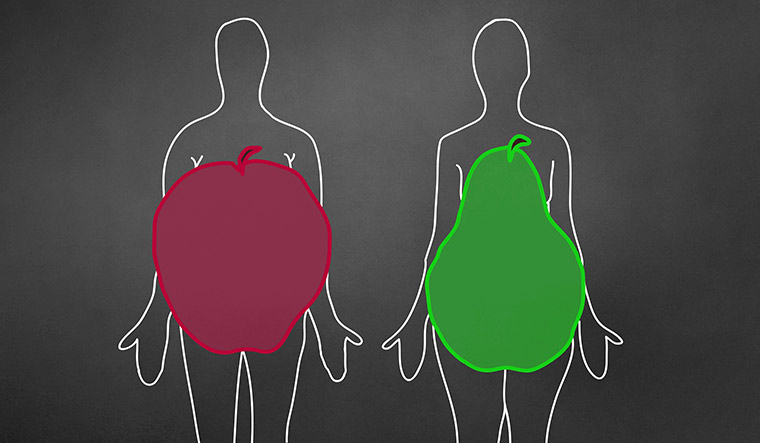
Your cardiovascular disease risk may depend on your body shape.
According to a US study published in the European Heart Journal, post-menopausal women who are apple-shaped have a greater risk of cardiovascular diseases, even if they are of normal weight, while pear-shaped women have a considerably lower risk.
To analyse if fat distribution impacted heart disease risk, the researchers followed 2,683 women with normal body mass index for nearly 18 years. None of the participants had cardiovascular disease at the start of the study. During the study period, 291 new cases occurred.
Women who stored most fat round their middle (apple shaped) had almost twice the risk of heart disease and stroke compared to women with the least fat stored around their middle. On the other hand, the risk was 40 per cent lower in women who stored the most fat in their legs (pear-shaped).
Women who had the highest percentage of fat around their middle and the lowest percentage of leg fat had more than three times greater risk compared to women with the least body fat and the most leg fat.
Stroke-triggering infections
Infections, especially urinary tract infections, may put you at risk of suffering a stroke.
For the study published in the journal Stroke, the researchers looked at the medical records of more than 190,000 people who had been treated for a stroke to see if they had been hospitalised for infections, including skin, urinary tract, septicaemia, abdominal and respiratory, at seven, 14, 30, 60, 90, and 120 days prior to the stroke occurrence.
Every type of infection increased the risk of ischaemic stroke, a type of stroke caused by blocked blood vessels in the brain. But UTIs showed the strongest link. Patients were more than three times as likely to suffer an ischaemic stroke within 30 days of an UTI. The risk was over five times greater in the week following an infection.
UTI, blood infection and respiratory infection increased the risk for intra-cerebral haemorrhage, which is caused by a ruptured blood vessel in the brain. Respiratory infection also increased the likelihood of subarachnoid haemorrhage, caused by bleeds in the inner lining of the brain.
Anticholinergic drugs and dementia risk
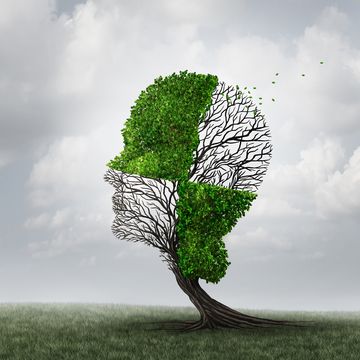
A commonly prescribed class of drugs has been shown to increase the risk of dementia. According to a British study published in the journal JAMA Internal Medicine, patients aged 55 and older who took anticholinergic medication daily for three years or more, had a 50 per cent increased risk of dementia.
Anticholinergic drugs work by blocking acetylcholine, a chemical that transmits messages in the nervous system. They are prescribed for a variety of health conditions, including chronic obstructive pulmonary disease, bladder conditions, depression, allergies, gastrointestinal disorders and Parkinson’s disease.
The researchers compared the medical records of 58,769 patients with dementia and 225,574 patients without dementia. All the patients were 55 and older.
The increased risk of dementia was especially seen in patients who took anticholinergic drugs for depression, Parkinson’s, bladder problems and epilepsy, and in people aged below 80, suggesting that “anticholinergic drugs should be prescribed with caution in middle-aged and older people”.
Risky treatment

Patients who receive radioactive iodine (RAI) treatment for hyperthyroidism have an increased long-term risk of cancer death from solid tumours, especially breast cancer. RAI is one of three commonly prescribed treatments for hyperthyroidism. The other two are anti-thyroid drugs and surgery.
The US study published in JAMA Internal Medicine included nearly 19,000 people with hyperthyroidism (mainly Graves’ disease) who received the radiation treatment between 1946 and 1964. None of them had cancer at the start of the study.
The researchers estimated radiation doses that each organ or tissue was exposed to as part of the treatment. While most of the radiation is absorbed by the thyroid gland, other organs like the breast and stomach are also exposed during treatment.
There was a dose-response relationship between the radiation dose absorbed by an organ and the risk of death from cancer at that site, especially for solid tumours in men and women, and for breast cancer in women.
Every 100 milligram of dose was associated with a 12 per cent increased risk of breast cancer death and 5 per cent greater risk of death from other solid cancers.
According to the study, for every 1,000 patients (average age 40) treated with RAI, there would be an additional 19 to 32 radiation-related solid cancer deaths.
Did You Know?
The risk of stillbirth increases with every week that a pregnancy continues beyond 37 weeks, which is considered full term. The risk increased by 87 per cent for deliveries at 42 weeks compared to 41 weeks of gestation.
PLOS Medicine
For timely detection

Prostate cancer often grows slowly and most men with a diagnosis do not require treatment. But the current prostate-specific antigen (PSA) blood tests cannot predict which tumours will become aggressive, making it hard for doctors to decide which men need further treatment.
About 75 per cent of men with a high PSA test result do not have prostate cancer when they have a biopsy. On the other hand, PSA test fails to spot cancer in about 15 per cent of men with prostate cancer.
Prostate urine risk (PUR), the new urine test, can predict which patients will require treatment, five years earlier than the current tests. PUR looks for genetic markers to make a more accurate diagnosis.
The researchers hope the new test would help low-risk patients on active surveillance avoid unnecessary and repeated biopsies.
The findings were published in the journal BJU International.
Yogurt to fight colon cancer

Eating yoghurt may lower the risk of colon cancer in men.
The study published in the journal Gut was based on 32,606 men and 55,743 women.
All of them had a colonoscopy between 1986 and 2012. During the study, 5,811 men and 8,116 women developed polyps or adenomas, which are abnormal growths that have the potential to turn cancerous.
Men who ate two or more servings of yoghurt a week were 19 per cent less likely to develop conventional adenomas compared with men who did not eat any yoghurt. They were also 26 per cent less likely to develop the kind of adenomas that have the highest potential to become cancerous.
However, the study did not find any link between yoghurt consumption and adenoma risk in women.
So how does yoghurt help fight cancer? According to the researchers, yoghurt may promote the growth of healthy bacteria in our gut. Two common probiotics found in yoghurt, lactobacillus bulgaricus and streptococcus thermophilus, may reduce acids and cancer-causing chemicals in the colon. Yoghurt may also reduce inflammation, which reduces cancer risk.
Using LASER antiretroviral therapy followed by gene editing, US researchers have successfully eliminated HIV from infected animals’ genome for the first time.
Nature Communications
Can cervical cancer be eradicated?

A global review of the impact of HPV vaccinations has shown significant reductions in human papillomavirus infections, genital warts and precancerous lesions that can lead to cervical cancer.
The HPV vaccine, offered to girls and boys, protects against the HPV strains—HPV 16 and 18—that cause 70 per cent of cervical cancers. It also provides protection against 90 per cent of the strains that cause genital warts.
For the study published in The Lancet, researchers reviewed 65 studies that included data collected over eight years from more than 60 million people in 14 countries.
Compared to rates before vaccination, HPV 16 and 18 dropped by 83 per cent in girls aged 13 to 19 years, and by 66 per cent among women aged 20 to 24, five to eight years after vaccination initiation. In addition, there was a 54 per cent reduction in three other types of HPV—31, 33 and 45—in teen girls.
Precancerous cervical lesions went down by 31 per cent in women aged 20 to 24 and 51 per cent in teen girls.
Cases of genital warts went down by 67 per cent in girls aged 15 to 19, 48 per cent in boys aged 15 to 19, 54 per cent in women aged 20 to 24, 32 per cent in men aged 20 to 24, and 31 per cent in women aged 25 to 29 years.
For your sexual health

Regular nut consumption can improve erectile and sexual function in healthy men.
Lifestyle factors, including smoking, excessive alcohol consumption, lack of physical activity, psychological stress, and unhealthy diets can negatively impact erectile and sexual function.
For the Spanish study published in the journal Nutrients, researchers assigned 83 healthy men, aged 18 to 35, to one of two groups. Men in the nut group were asked to add 60g raw mixed nuts (hazelnuts, almonds, and walnuts) daily to their usual western-style diet for 14 weeks, while those in the control group followed their usual western-style diet without any nuts.
The nut intervention group reported significant increase in the orgasmic function and sexual desire at the end of the study period compared to the control group.
“Our study suggests that compliance with a healthy diet supplemented with mixed nuts may help improve erectile function and sexual desire,” the study concluded.
Hidden recovery signals
There is no clear way for doctors to predict which patients will recover from coma after a brain injury. Neurological examinations and other tests that are currently used by doctors to estimate the likelihood of recovery are often inaccurate.
According to a study published in the New England Journal of Medicine, some patients in coma may show signs of hidden consciousness that are detectable with EEGs just days after injury and those patients are more likely to get better.
The study was based on 104 unresponsive adult patients who had suffered a sudden brain injury due to internal bleeding, trauma, or oxygen deprivation. They were unable to talk and did not respond to commands to move.
The researchers used EEG to scan the brain waves of the patients as they were asked many times to open and close their hands or stop opening and closing their hands. Using an algorithm, the brain waves were then analysed to see if there were different patterns of activity, suggesting that the patients could differentiate between the two commands even though they could not act on it.
Fifteen per cent of the patients had brain activity patterns suggesting hidden consciousness within four days of the injury. Among them, 50 per cent were able to follow verbal commands before being discharged from hospital compared to 26 per cent of those without such brain activity.
A year later, 44 per cent of patients with the brain activity patterns were able to function independently for eight hours daily, compared with only 14 per cent of those without such brain activity.
About 81 per cent of antibiotics prescribed by dentists before dental procedures to prevent infections are unnecessary.
JAMA Network Open
Beware, workaholics

People who regularly work long hours have a higher risk of stroke, especially if they do so for ten years or more, according to a French study published in the journal Stroke.
The study defined long hours as working more than ten hours for at least 50 days a year.
The risk was similar for both men and women, but greatest for people younger than 50. The study included 143,592 participants, 29 per cent of whom reported working long hours and 10 per cent reported working long hours for a decade or more.
Among them, 1,224 had suffered a stroke.
Working long hours was associated with a 29 per cent greater risk of stroke. The risk was 45 per cent greater for those who worked long hours for ten years or more.
Part-time workers and those who suffered a stroke before working long hours were excluded from the study.
CONTRIBUTOR: SHYLA JOVITHA ABRAHAM
Home — Essay Samples — Environment — Natural Environment — Benefits of Nature in Well-being
Benefits of Nature in Well-being
- Categories: Natural Environment
About this sample

Words: 2628 |
14 min read
Published: Dec 12, 2018
Words: 2628 | Pages: 6 | 14 min read
Works Cited
- Kaplan, S. (1995). The restorative benefits of nature: Toward an integrative framework. Journal of Environmental Psychology, 15(3), 169-182.
- Kuo, F. E., & Taylor, A. F. (2004). A potential natural treatment for attention-deficit/hyperactivity disorder: evidence from a national study. American Journal of Public Health, 94(9), 1580-1586.
- Mayer, F. S., Frantz, C. M., Bruehlman-Senecal, E., & Dolliver, K. (2008). Why is nature beneficial? The role of connectedness to nature. Environment and Behavior, 41(5), 607-643.
- Selhub, E. M., & Logan, A. C. (2012). Your brain on nature: The science of nature's influence on your health, happiness, and vitality. Wiley.
- Ulrich, R. S. (1984). View through a window may influence recovery from surgery. Science, 224(4647), 420-421.
- Ulrich, R. S., Simons, R. F., Losito, B. D., Fiorito, E., Miles, M. A., & Zelson, M. (1991). Stress recovery during exposure to natural and urban environments. Journal of Environmental Psychology, 11(3), 201-230.
- Wilson, E. O. (1984). Biophilia. Harvard University Press.
- World Health Organization. (2016). Urban green spaces and health: A review of evidence. World Health Organization. https://apps.who.int/iris/bitstream/handle/10665/204585/9789241565196_eng.pdf;jsessionid=86DEB82E1A0B29BB82B04B193D8C33FC?sequence=1
- Yoshifumi, M., & Miyazaki, Y. (2010). Effects of a forest environment on human natural killer (NK) activity and anti-cancer protein production. Acta Medica Nagasakiensia, 54(4), 63-70.
- Zeitzer, J. M., & Ruby, N. F. (2010). Why we nap: Evolution, chronobiology, and functions of polyphasic and ultrashort sleep. Springer.

Cite this Essay
Let us write you an essay from scratch
- 450+ experts on 30 subjects ready to help
- Custom essay delivered in as few as 3 hours
Get high-quality help

Prof. Kifaru
Verified writer
- Expert in: Environment

+ 120 experts online
By clicking “Check Writers’ Offers”, you agree to our terms of service and privacy policy . We’ll occasionally send you promo and account related email
No need to pay just yet!
Related Essays
2 pages / 745 words
1 pages / 490 words
3 pages / 1212 words
3 pages / 1515 words
Remember! This is just a sample.
You can get your custom paper by one of our expert writers.
121 writers online
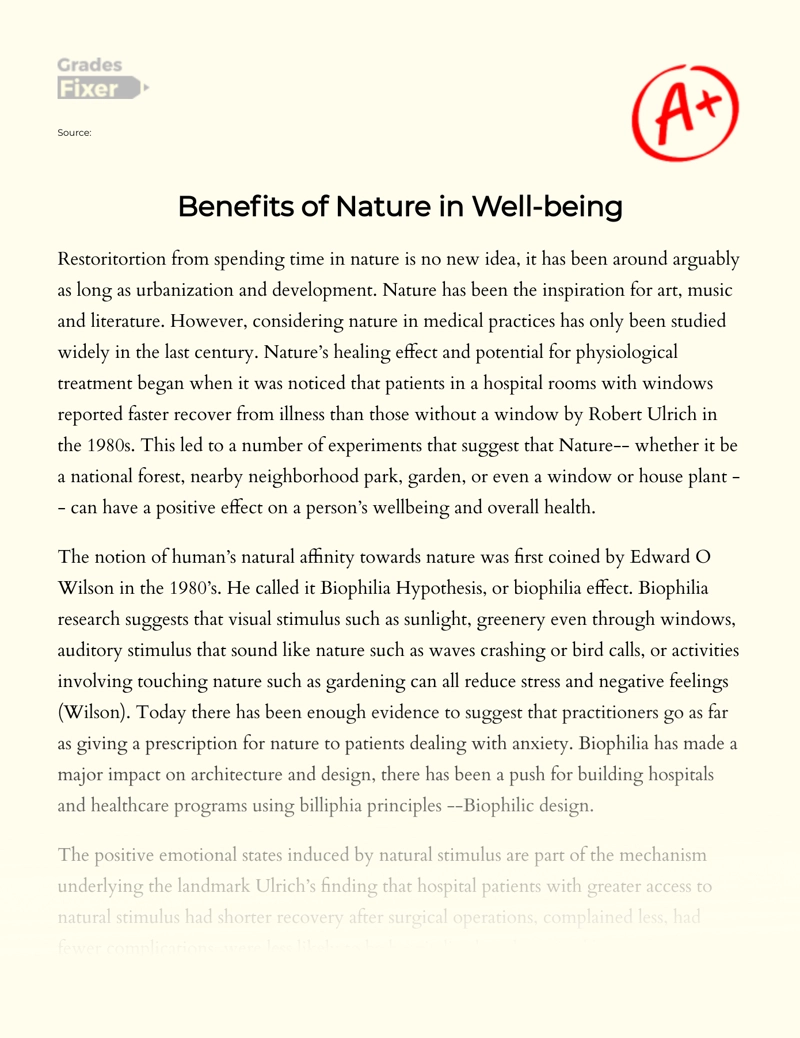
Still can’t find what you need?
Browse our vast selection of original essay samples, each expertly formatted and styled
Related Essays on Natural Environment
Environmental stewardship is a guiding principle that recognizes our collective responsibility to care for and protect the natural world that sustains us. In an era marked by environmental challenges such as climate change, [...]
Delgado, J. P. (2008). Khubilai Khan's Lost Fleet: In Search of a Legendary Armada. HarperCollins.Seymour, G. (1995). Divided Loyalties: Fort St. George During the American Revolution. Rutgers University Press.Belloc, H. (1926). [...]
In conclusion, environmental protection is critical for our planet's sustainability, human health, and the global economy. By prioritizing sustainable practices, collective responsibility, and comprehensive solutions, we can [...]
Capgemini Research Institute. (2020). Retail meets sustainability 2020. Retrieved from https://www.theguardian.com/society/2019/sep/26/global-depression-rates-rise-18-since-2005-who-says
What is a cave? A cave is an underground hollow place large enough for a human to enter. The formation and development of caves are known as speleogenesis, which can occur over the course of millions of years. Caves are formed [...]
Forestry was commonly a misunderstood topic in which it was thought to be the study of trees alone, yet in actuality is much more. Forestry, in short, is known to be the science and understanding of managing forest trees and [...]
Related Topics
By clicking “Send”, you agree to our Terms of service and Privacy statement . We will occasionally send you account related emails.
Where do you want us to send this sample?
By clicking “Continue”, you agree to our terms of service and privacy policy.
Be careful. This essay is not unique
This essay was donated by a student and is likely to have been used and submitted before
Download this Sample
Free samples may contain mistakes and not unique parts
Sorry, we could not paraphrase this essay. Our professional writers can rewrite it and get you a unique paper.
Please check your inbox.
We can write you a custom essay that will follow your exact instructions and meet the deadlines. Let's fix your grades together!
Get Your Personalized Essay in 3 Hours or Less!
We use cookies to personalyze your web-site experience. By continuing we’ll assume you board with our cookie policy .
- Instructions Followed To The Letter
- Deadlines Met At Every Stage
- Unique And Plagiarism Free
Nature Essay for Students and Children
500+ words nature essay.
Nature is an important and integral part of mankind. It is one of the greatest blessings for human life; however, nowadays humans fail to recognize it as one. Nature has been an inspiration for numerous poets, writers, artists and more of yesteryears. This remarkable creation inspired them to write poems and stories in the glory of it. They truly valued nature which reflects in their works even today. Essentially, nature is everything we are surrounded by like the water we drink, the air we breathe, the sun we soak in, the birds we hear chirping, the moon we gaze at and more. Above all, it is rich and vibrant and consists of both living and non-living things. Therefore, people of the modern age should also learn something from people of yesteryear and start valuing nature before it gets too late.

Significance of Nature
Nature has been in existence long before humans and ever since it has taken care of mankind and nourished it forever. In other words, it offers us a protective layer which guards us against all kinds of damages and harms. Survival of mankind without nature is impossible and humans need to understand that.
If nature has the ability to protect us, it is also powerful enough to destroy the entire mankind. Every form of nature, for instance, the plants , animals , rivers, mountains, moon, and more holds equal significance for us. Absence of one element is enough to cause a catastrophe in the functioning of human life.
We fulfill our healthy lifestyle by eating and drinking healthy, which nature gives us. Similarly, it provides us with water and food that enables us to do so. Rainfall and sunshine, the two most important elements to survive are derived from nature itself.
Further, the air we breathe and the wood we use for various purposes are a gift of nature only. But, with technological advancements, people are not paying attention to nature. The need to conserve and balance the natural assets is rising day by day which requires immediate attention.
Get the huge list of more than 500 Essay Topics and Ideas
Conservation of Nature
In order to conserve nature, we must take drastic steps right away to prevent any further damage. The most important step is to prevent deforestation at all levels. Cutting down of trees has serious consequences in different spheres. It can cause soil erosion easily and also bring a decline in rainfall on a major level.

Polluting ocean water must be strictly prohibited by all industries straightaway as it causes a lot of water shortage. The excessive use of automobiles, AC’s and ovens emit a lot of Chlorofluorocarbons’ which depletes the ozone layer. This, in turn, causes global warming which causes thermal expansion and melting of glaciers.
Therefore, we should avoid personal use of the vehicle when we can, switch to public transport and carpooling. We must invest in solar energy giving a chance for the natural resources to replenish.
In conclusion, nature has a powerful transformative power which is responsible for the functioning of life on earth. It is essential for mankind to flourish so it is our duty to conserve it for our future generations. We must stop the selfish activities and try our best to preserve the natural resources so life can forever be nourished on earth.
{ “@context”: “https://schema.org”, “@type”: “FAQPage”, “mainEntity”: [ { “@type”: “Question”, “name”: “Why is nature important?”, “acceptedAnswer”: { “@type”: “Answer”, “text”: “Nature is an essential part of our lives. It is important as it helps in the functioning of human life and gives us natural resources to lead a healthy life.” } }, { “@type”: “Question”, “name”: “How can we conserve nature?”, “acceptedAnswer”: { “@type”: “Answer”, “text”: “We can take different steps to conserve nature like stopping the cutting down of trees. We must not use automobiles excessively and take public transport instead. Further, we must not pollute our ocean and river water.” } } ] }
Customize your course in 30 seconds
Which class are you in.

- Travelling Essay
- Picnic Essay
- Our Country Essay
- My Parents Essay
- Essay on Favourite Personality
- Essay on Memorable Day of My Life
- Essay on Knowledge is Power
- Essay on Gurpurab
- Essay on My Favourite Season
- Essay on Types of Sports
Leave a Reply Cancel reply
Your email address will not be published. Required fields are marked *
Download the App


Essay on Benefits of Nature
Students are often asked to write an essay on Benefits of Nature in their schools and colleges. And if you’re also looking for the same, we have created 100-word, 250-word, and 500-word essays on the topic.
Let’s take a look…
100 Words Essay on Benefits of Nature
The healing power of nature.
Nature is a great healer. It brings peace to our minds and bodies. When we spend time in nature, we feel calm and relaxed. It reduces stress and improves our mood.
Nature and Physical Health
Learning from nature.
Nature is a fantastic teacher. It teaches us about the cycles of life, the importance of diversity, and the need for balance. It inspires creativity and sparks curiosity in young minds.
250 Words Essay on Benefits of Nature
The therapeutic power of nature.
The natural world has been a source of solace, inspiration, adventure, and delight for generations. It is a sanctuary for the human spirit, offering a sense of peace and tranquility that is often lacking in our fast-paced, technology-driven lives.
Mental Health Enhancement
Physical health improvement.
In addition to mental health, nature also contributes to our physical well-being. Activities such as hiking, cycling, or simply walking in a park can improve cardiovascular health, enhance physical strength, and boost the immune system. Moreover, exposure to sunlight helps the body produce Vitamin D, crucial for bone health and disease prevention.
Fostering Creativity and Mindfulness
Nature can stimulate our creativity and foster a sense of mindfulness. The beauty and complexity of natural patterns, shapes, and colors can inspire artistic and innovative thoughts. Moreover, the quietude of nature encourages mindfulness, promoting a deep sense of connection with our surroundings and ourselves.
Sustainable Living and Climate Change Mitigation
Finally, nature teaches us the principles of sustainable living. Understanding and appreciating the intricate balance of ecosystems can inspire us to adopt more sustainable practices, reducing our carbon footprint and contributing to climate change mitigation.
In conclusion, the importance of nature in our lives cannot be overstated. As we navigate through the complexities of the modern world, let us remember to take the time to reconnect with nature and reap its numerous benefits.
500 Words Essay on Benefits of Nature
The natural world has a profound impact on our well-being. A growing body of research suggests that exposure to nature can lead to a wealth of health benefits, both physical and mental. The Japanese practice of ‘Shinrin-Yoku’, or ‘forest bathing’, has been scientifically proven to reduce stress levels, lower blood pressure, and improve mood.
The Physical Benefits of Nature
Nature and mental health.
The mental health benefits of nature are equally significant. Natural environments can act as a buffer against stress, helping to restore our attention and relax our minds. A study published in the journal “Environmental Science & Technology” found that just five minutes of exercise in a green space can dramatically improve mood and self-esteem.
Nature and Cognitive Function
Nature’s impact extends to our cognitive abilities as well. Research indicates that exposure to natural settings can enhance memory and attention span. A study from the University of Michigan found that walks in nature could improve short-term memory by 20%. The calming effect of nature helps to clear the mind, allowing for better concentration and creativity.
Connecting with Nature
Despite these benefits, urbanization and technology have led to a disconnection from nature. It is crucial to reintegrate nature into our daily lives. This can be as simple as taking a walk in a local park, gardening, or even bringing plants into your home or workspace.
Nature and Sustainability
In conclusion, nature offers a plethora of benefits to our physical and mental well-being. It is a powerful yet underutilized tool for health and happiness. As we move forward in an increasingly urbanized world, it is crucial to reconnect with nature and reap its many benefits.
Apart from these, you can look at all the essays by clicking here .
Happy studying!
Leave a Reply Cancel reply

Quote of the Month:
“ Nature gives to every time and season some beauties of its own ." - Charles Dickens

- Amazing Washington 1
- Amazing Washington 2
- Amazing Washington 3
- Amazing Washington 4
- Amazing Washington 5
- Amazing Washington 6
- Amazing Washington 7
- Amazing Washington 8
- Amazing Washington 9
- Amazing Washington 10
- Amazing Washington 11-SEATTLE
- Amazing Washington 12
- Amazing Washington 13
- Olympic Peninsula
- Eastern Washington
- South Cascades
- Mount Rainier
- North Cascades
- Snoqualmie Region
- Central Cascades
- 4K Films about Washington
- 4K Nature Relaxation Videos
- State Parks
- National Parks
- Wildlife Refuges
- National Monuments
- Adams County
- Asotin County
- Benton County
- Chelan County
- Clallam County
- Clark County
- Columbia County
- Cowlitz County
- Douglas County
- Ferry County
- Franklin County
- Garfield County
- Grant County
- Grays Harbor County
- Island County
- Jefferson County
- King County
- Kitsap County
- Kittitas County
- Klickitat County
- Lewis County
- Lincoln County
- Mason County
- Okanogan County
- Pacific County
- Pend Oreille County
- Pierce County
- San Juan County
- Skagit County
- Skamania County
- Snohomish County
- Spokane County
- Stevens County
- Thurston County
- Wahkiakum County
- Walla Walla County
- Whatcom County
- Whitman County
- Yakima County

All the videos are for HOME USE ONLY! If you want to use videos un your business, please, contact us at [email protected]
Nature is the best healer.

According to statistics, more and more people become residents of large cities. We quickly get used to the city; it lures us into its tempo and rhythm. And very often amidst all the hustle and bustle of our life there we do not realize how frazzled, stressed and worn out we became.
It is quite interesting that in spite of the fact that there are a huge amount of various articles on this topic, and scientists are conducting numerous researches in this field, but still the vast majority of city dwellers rarely remember about the easiest way to unload themselves from the burden of thousands of problems and issues they have to resolve in their everyday life and to escape from this strenuous, killing pace of life, giving rest to their body and brain.
Mankind originated and for thousands of years existed in midst of nature. The habit of urban life emerged only recently and has not yet had time to gain a foothold genetically. And as we find ourselves in the nature, we feel an amazing sense of peace and calmness, consonant with the outside world and with our individual self.

Feel yourself the refreshing and beneficial influence of nature during a hike or an easy stroll. When you are in nature your blood pressure goes down, the silence delights the ear and envelops the body, and of course moving in the open air is much easier and more ravishing than indoors. Physical activity is especially useful in the nature and besides of that brings lots of fun for kids. Amazing nature of Washington State presents excellent opportunities to improve your physical health and bring in order your state of mind.
Nature has always invigorated people, giving them strength and health. In the past people’s lives depended largely on nature. Today, for most people time spent outdoors in the midst of unbelievably beautiful landscape brings some special peace of mind and opens many options of outdoor activities. It doesn’t matter what you chose – a pleasant stroll among the trees along the narrow paths of some city park or camping and hiking in the mountains, exploring the beauty of pristine nature – you will only benefit from this, maintaining your health and resisting the general deterioration of health in modern society, resulting from decreased physical activity and sedentary lifestyle.

Nature has a positive effect on health and well-being, at least in three areas:
• Physical activity increases in the open air : nature implies movement. Even without noticing it, in nature we move much faster and more vigorously than indoors, even the physical exercises seem easier.
Pure and beautiful nature is the best place for sports. In nature’s lap attention is concentrated not only on the physical exercises, but also on the environment. Therefore, hike in the woods can often seem less strenuous than going in for sports indoors. In contrast to the urban environment, a variety of natural landscapes and sceneries provide an opportunity for a more agile and lightsome walk.
• Nature revivifies man to life and helps to recover from stress : the attention concentration improves, and the heart rate, as well as blood pressure, decrease.
Picturesque landscapes, sounds and smells help to free our mind from tasks requiring concentration. Nature helps the body to rest and recover from all the accumulated stress and the brain to work well.
Rapidly developing information overload and the lifestyle, where most of the day is spent in front of a computer screen and other electronic equipment, set certain requirements for brain health and efficiency. Tasks which require sustained attention predispose to stress and fatigue. Our creativity and concentration deteriorate, if the brain at least from time to time does not get a chance to recover from the strain
David Strayer , a well-known cognitive psychologist from the University of Utah, who studies peculiarities of attention, claims that nature and beautiful landscapes help to relieve stress and increase the efficiency of the brain. He conducted numerous experiments to prove his theories.
One of the experiments was conducted with 54 volunteers, whose average age was 28 years, to prove that a camping trip to the woods for 3-6 days, during which it was forbidden to use electronic devices, significantly improves the mental abilities of people. The participants of the experiment were tested firstly at the beginning of the camping trip and then after it. The results showed that initially they received in average 4,14 points and after the camping – 6,08 points.

In another experiment, 22 student volunteers went for a hiking trip. Again, tests have shown that they were able to solve the problem tasks and perform creative assignments after three days of the trip up to 50% more efficient than before the trip.
As a result of his experiments David Strayer discovered " the effect of three days ." He believes that the nature and beautiful scenery is an excellent remedy for stress and a way to improve brain functioning, and in order for it to work, it is enough to stay outdoors for three days. He compares staying in nature to shine washing the windshield of your car – in both cases, as he says, the picture of the world becomes clear.
• Staying on nature contributes social well-being and sense of community : we positively respond to other people, and our mood gets better pretty quickly.
Nowadays, social isolation and loneliness is a common phenomenon in many countries, both in cities and in remote areas. Scientific evidence shows that surrounding us natural environment has properties that make people feel better, even socially. Proximity to nature, staying and working in nature makes people to deliberate and to think more positively not only about themselves but also about other people! Staying alone in nature is perceived better than in the urban environment. Nature strengthens the sensations: a sense of community and of belonging to a place and unified whole can be increased.
Even a short walk in nature is beneficial!
Another researcher Matilda van den Bosch has studied the influence of virtual nature on a person. Her experimental were subjected to stress: they solve complex problems on the speed or were interviewed for a job. They were then sent to a virtual forest with beautiful views and birds singing. As a result, their heart rate quickly returned to normal, which means that the virtual nature also has a calming effect on us.
All this proves that many of us already knew intuitively: nature helps us to get rid of stress and picturesque landscape heals !
That is why we would like to offer you an amazing relaxation video, which will wash you stress away and will help you to relax and feel refreshed.
To see more Nature Relaxation Videos you may subscribe to our Relaxation Channel, offering numerous incredible nature relaxation videos, which will help you to deal with everyday strain and tension of the modern life:
https://www.youtube.com/channel/UCg72Hd6UZAgPBAUZplnmPMQ?sub_confirmation=1
If you want to enjoy our Relaxation Videos in fantastic 4K quality, you may order them at http://www.beautifulwashington.com/shop/nature-relaxation-videos/
Photo: Roman Khomlyak
Photo Editing: Juliana Voitsikhovska
Information: Svetlana Baranova
Leave your comment
- Name (Required):
- Email (Required):

You are using an outdated browser. Please upgrade your browser to improve your experience.
Nature as a healer
International Day of Forests is on 21 March and this year’s theme is Forests and Sustainable Cities. The day #internationaldayofforests is a great opportunity for us to look at nature as a healer, and how it can help, heal and protect us.
International Day of Forests is on 21 March and this year’s theme is Forests and Sustainable Cities. The day #internationaldayofforests is a great opportunity for us to look at nature as a healer, and how it can help, heal and protect us.
We instinctively know that spending time in nature is great for both the body and mind, but now a growing body of research suggests that it can benefit our mental health.
According to researchers, a lack of exposure to natural surroundings may be one of the causes behind many modern ills; including depressive symptoms and anxiety attacks.
“A lack of exposure to natural surroundings may be one of the causes behind many modern ills.”
One study from The University of Exeter Medical School in England looked at the mental health data of 10,000 city dwellers and used mapping to track where the subjects had lived over the past 18 years. The findings suggested that people living near urban green space reported less mental distress. A second study from 2009, found a lower incidence of 15 diseases, including depression, anxiety, heart disease, diabetes, asthma, and migraines in people who lived within a half mile of green space.
Another study compared a 50-minute walk in a city environment to a nature walk. A nature walk decreased the activity in an area of the brain linked to the risk of mental illness. Nature walks have also been found to reduce rumination – the negative thoughts that people return to over and over, which will be familiar to anyone suffering from anxiety.
With this knowledge, doctors are increasingly prescribing trips to the park for a range of conditions, including anxiety, depression and stress. In some countries, “exposure to nature” is a core component of therapy and it’s even spawning new fields like ecopsychology.
This growing body of evidence shows that time spent outdoors can:
- reduce stress levels
- lessen symptoms of depression
- reduce anxiety
- lower blood pressure, heart rate, muscle tension
- lower production of stress hormones such as cortisol.
Nature as a healer – around the world
With the knowledge that urban green spaces and forests encourage active and healthy lifestyles, provide a place for people to socialise, and improve mental health, governments around the world are taking notice and promoting nature experiences as a public health policy.
Nature as a healer – Finland
In Finland, government-funded researchers asked thousands of people to rate their moods and stress levels after visiting both natural and urban areas. Based on that study, the team at the Natural Resources Institute Finland recommended a minimum nature dose of five hours a month, with several short visits a week. They reported that a 40 to 50-minute walk was enough for physiological and mood changes to take place. They even designed six “power trails” that encourage walking, mindfulness, and reflection, with signs quoting sayings like, “Squat down and touch a plant”.
Nature as a healer – Switzerland
In a small suburb of Zurich, Switzerland, children spend the majority of their school day in the woods, regardless of the weather. Known locally as the “forest kindergarten” they’re able to explore and learn whittling and den-building. Supporters say these schools build self-confidence and foster an independent spirit.
Nature as a healer – South Korea
Many South Korean’s suffer from work stress and long working hours. A survey commissioned by Samsung reported 70% of people said their jobs made them depressed. In attempting to address this, the South Korean government embraced the medicalisation of nature and built “healing forests” near every major town. Each healing forest offers programs from meditation to woodcrafts. There is also a government-run “happy train” that takes children who have experienced bullying into the woods for two days of camping.
Nature as a healer – How can you spend more time in nature?
The great news is that it’s easy to experience a dose of all mother nature provides, by:
- Packing a backpack and heading for the hills
- Preparing a picnic basket and visiting a local park
- Go walking on the beach
- Organising a camping trip with your mates
- Walking the dog in some nice natural surrounds
- Laying on the grass and watching the clouds float by
- Taking up gardening or sitting quietly in your garden
- Visiting a forest. Check out this article from Australian Geographic about Australia’s diverse forests .
The more time spent in nature, the more balanced you will feel. Nature provides great stress relief by enabling us to remove ourselves from the things that cause us stress in the first place.
So if you’re struggling with depression or anxiety, visit a forest and focus your senses of sight, sound, smell, taste, and touch on our natural surroundings. Walk barefoot, sleep outdoors in a swag, collect shells or unusual pieces of wood, and breathe in the fresh air.
If you need support, call Suicide Call Back Service on 1300 659 467 .
If it is an emergency, call 000.
More from mental health
Symptoms and causes of anxiety.
Anxiety is more than a passing feeling of being worried or nervous when you have an important or stressful event coming up. When anxiety is long term and doesn’t go away after a stressful event, it can start to affect your everyday life. Here we look at the anxiety symptoms and causes of anxiety.
Grief, loss and 'Sorry Business'
Grief is an emotional response to loss, which might include the death of a loved one, loss of health, ending of a relationship, loss of a job, or a loss of cultural connection, such as moving off country. It is important to acknowledge and express those feelings without judgement.
Managing workplace stress
Are you feeling overwhelmed at work? You’re not alone. Workplace stress can impact all of us. This article explores the causes of stress at work and equips you with strategies to manage it
Loneliness and social relationships - 14 tips to connect with others
Feeling connected to others is important for our wellbeing. Strong social connections and relationships can have positive effects on our physical and mental health. Here we explore 14 tips from psychologists at the Australian Psychological Society to help you build stronger connections and reduce feelings of loneliness.
How to build a strong support network
When it comes to our mental health and wellbeing, studies have shown that having a good support network with strong relationships you can count on, is vital. A support network refers to those people in your life that are there for you when you need them and can help you to achieve your goals. Read our tips on how to create a strong support network.
What are mood disorders?
Mood disorders can often cause severe and prolonged changes in mood and can affect your ability to engage in everyday life activities. Read here to learn about the causes, symptoms, and treatments available.

IMAGES
VIDEO
COMMENTS
Essay: The Healing Power of Nature. While waiting for a hike to begin during Earth Week last spring at Kehl Lake, I felt my phone buzzing in my pocket. Glancing at the screen, I saw it was a close friend of mine, a college roommate, who dislikes talking on the phone, and almost never calls. I picked up.
For millennia, people have held to the notion that spending time in nature is healing and restorative. Hippocrates stated that "Nature itself is the best physician". At some point in our lives, many of us have gone on an adventure into nature and left feeling rejuvenated and relaxed.
Nature employs the mind without fatigue and yet enlivens it. Tranquilizes it and enlivens it. And thus, through the influences of the mind over body, gives the effect of refreshing rest and reinvigoration to the whole system. It took almost 150 years, but science has verified that statement almost word for word, including by researchers ...
Nature is undoubtedly the best healer. Spending time in nature awakens our senses and provides clarity. Many studies have proved that people who have a close connection to the landscapes are happier from the inside - they indulge themselves in positive thinking and have better coping mechanisms than others.
The exact mechanism of how nature helps mood disorders is unclear, but researchers agree that at the very least, time in nature tends to lift spirits. "When you have a short blast of nature ...
As naturopathic physicians, we believe in the importance of nature for healing. In the pages ahead, you will learn the health benefits of being in nature, how to use nature as a part of a meditative practice and healing ... their best efforts to eat healthy and work out, they struggle with life's common health complaints of anxiety and ...
We humans have always been interested in the healing power of nature. There are numerous philosophical works, books, poems, and songs about nature's beauty and its effect on our bodies, minds, and souls. One of the most famous nature gurus, Henry David Thoreau, has famously said: 'There are moments when all anxiety and stated toil are ...
Nature is a tonic for physical well-being. It reduces blood pressure, stables heart rate, and decreases the production of stress hormones. One study suggested that the nature view helps patients ...
In the meantime, while our senses are absorbed in smelling, seeing, hearing, touching, tasting the Nature around us, a cascade of health benefits floods through our minds and bodies. According to ...
The Hippocratic physicians identified one potential answer: the healing power of nature. Doctors, they taught, are merely nature's servants. They took their diagnostic and therapeutic cues from ...
Evidence that experiences of nature can benefit people has accumulated rapidly. Yet perhaps because of the domination of the visual sense in humans, most research has focused on the visual aspects of nature experiences. However, humans are multisensory, ...
Read seven proves ways why nature can, indeed, be the best healer you have at your disposal. Take a look at these benefits.
Explore the profound insights of Ralph Waldo Emerson in 'Nature.' Delve into the beauty of his philosophical musings on the connection between humanity and the natural world.
Nature, the best healer. Spending just two hours a week in nature may promote physical and mental well-being, according to a British study published in the journal Scientific Reports. The study was based on a survey of nearly 20,000 people in England who were asked to rate their general health and well-being, and also answered questions about ...
The beauty of nature is a priceless gift that enriches our lives in countless ways. Its aesthetic appeal, healing power, role in biodiversity, and influence on human creativity all contribute to its profound impact on our physical, mental, and emotional well-being. As we continue to navigate the challenges of the modern world, it is essential ...
Active participation in nature has additionally been found to reduce mental distress, enhance self-confidence and improve physical health of the participants. Nature has an effect on physiology, Exposure to natural environments had a direct influence on urine and blood levels of cortisol, a stress-related hormone.
Nature is an important and integral part of mankind. It is one of the greatest blessings for human life; however, nowadays humans fail to recognize it as one. Nature has been an inspiration for numerous poets, writers, artists and more of yesteryears. Read Nature essay here.
Let's take a look… 100 Words Essay on Benefits of Nature The Healing Power of Nature. Nature is a great healer. It brings peace to our minds and bodies.
Nature has a positive effect on health and well-being, at least in three areas: • Physical activity increases in the open air: nature implies movement. Even without noticing it, in nature we move much faster and more vigorously than indoors, even the physical exercises seem easier. Pure and beautiful nature is the best place for sports.
Explore the incredible healing potential of nature in our latest video, "Nature: The Best Healer." Delve into the art of paragraph writing as we uncover how ...
Nature as a healer - Finland. In Finland, government-funded researchers asked thousands of people to rate their moods and stress levels after visiting both natural and urban areas. Based on that study, the team at the Natural Resources Institute Finland recommended a minimum nature dose of five hours a month, with several short visits a week ...
Nature the best healer 80 to 100 words paragraph . Nature: the best healer. The paragraph is given below. It is the body itself, that has an inherent ability to heal itself. This ability of our body is recognized by the healing power of nature. You feel more balanced as you spend more time in nature.
Nature gives extraordinary relief help by empowering us to eliminate ourselves from the things that cause us stress in any case. Nature as the best healer: Nature is a tonic for actual prosperity. It diminishes circulatory strain, corrals pulse, and diminishes the development of stress hormones. At the point when we are presented with nature ...